A dark floor can be the design ace that instantly makes a kitchen feel collected, modern, and undeniably chic. Black under-footing lends instant drama, hides minor scuffs, and spotlights every other texture — whether that’s warm oak cabinets or gleaming brass hardware. Because a floor dominates square footage, choosing the right material, finish, and pattern matters just as much as the color itself. Below are 25 fresh, practical ideas that show how a black floor kitchen can adapt to almost any style, from cost-friendly vinyl planks to terrazzo speckled with brass. Let these concepts spark new possibilities for your own cooking headquarters.
1. Slate-Tiled Serenity
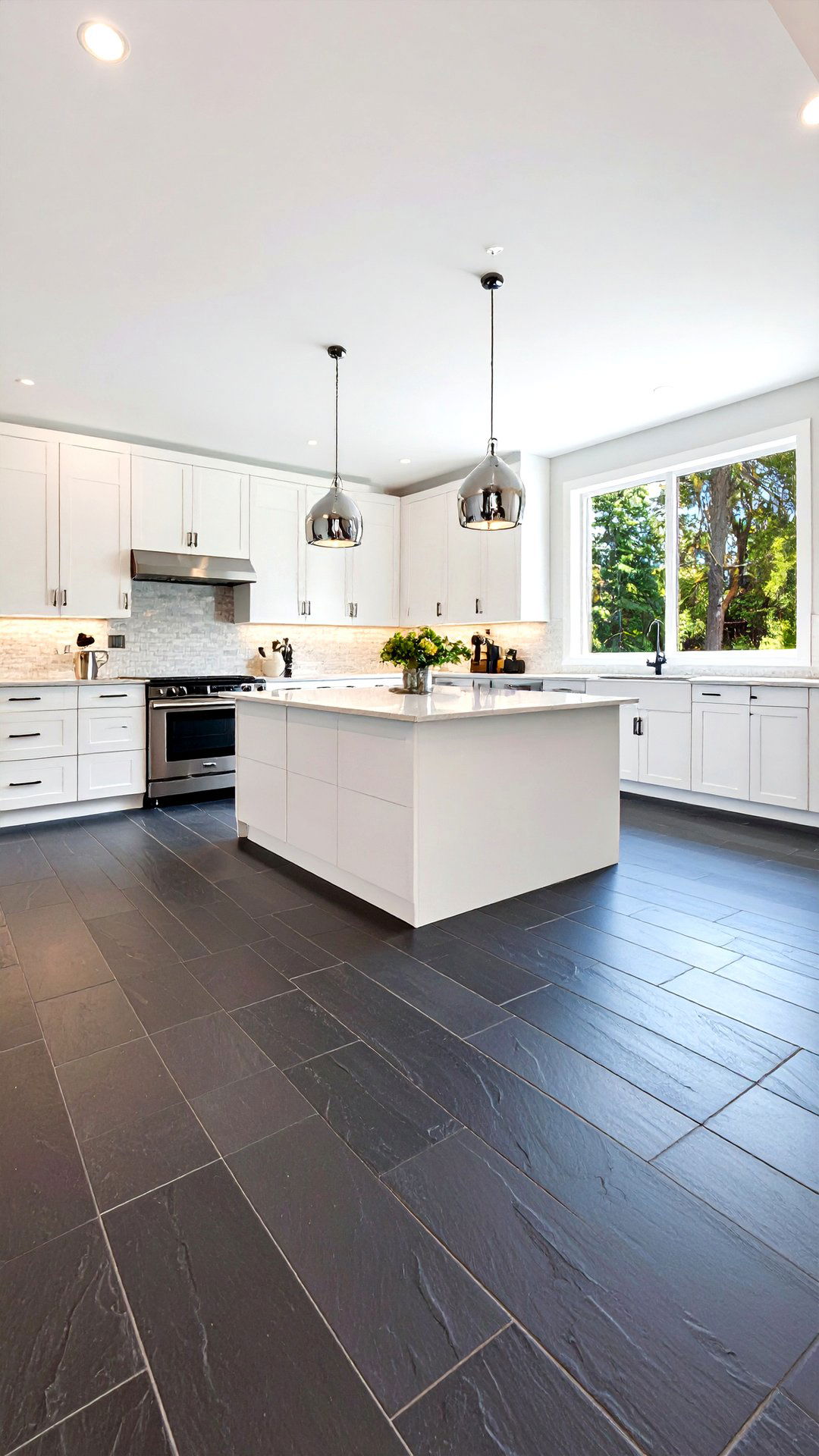
A soft-sheen slate floor grounds a bright, open-plan black floor kitchen and brings a subtle rippled texture that hides crumbs between moppings. Opt for large 24-inch rectangles set with tight joints so grout lines don’t interrupt the slate’s natural layering. Because slate retains heat, pairing it with a low-profile radiant system keeps toes cozy year-round. Finish the room with matte white cabinetry and slimline stainless appliances — the gentle contrast allows the black floor to read as an intentional canvas rather than an afterthought. Regular sealing every three years maintains color depth without making the stone glossy.
2. Matte Porcelain Minimalism
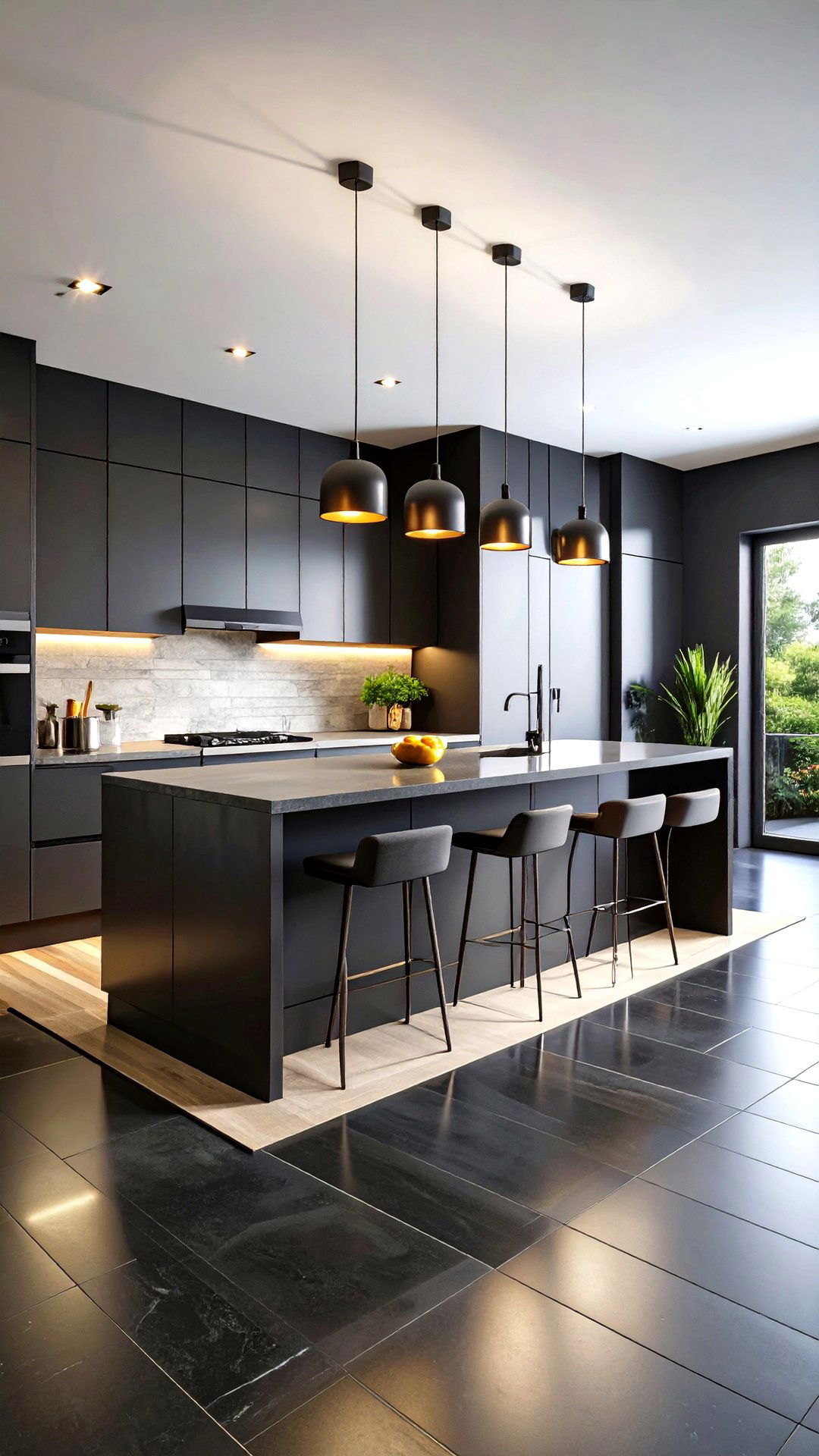
For homeowners who crave a fuss-free surface, ultra-matte porcelain tiles in true ebony offer an indestructible base that shrugs off scratches, water, and dropped utensils. Choose rectified edges so each piece butts perfectly, mimicking an unbroken slab and amplifying a minimalist kitchen aesthetic. Subtle variation inside the tile body prevents the black from feeling flat, while zero-sheen finishes tame glare from under-cabinet LEDs. Add integrated finger-pull doors in the same color family to create a gallery-like cocoon — ideal for artful pendant lights or a sculptural island centerpiece.
3. Checkerboard Comeback

One enduring 2025 favorite? A black-and-white checkerboard that turns meal prep into a Parisian bistro moment. Pairing jet-black squares with warm cream rather than stark white softens the contrast and feels current — not retro. Ceramic or porcelain keeps maintenance simple, yet swapping marble tiles introduces luxurious veining. Position the pattern on a 45-degree angle to widen narrow galley kitchens and visually push cabinetry outward. Designers credit the checkerboard revival to its blend of nostalgia and graphic punch, catapulting it into flooring trend round-ups this year.
4. Herringbone Hardwood Drama

Take classic oak planks, stain them midnight, and lay them in a tight herringbone to deliver movement without color noise. Because black can obscure grain, wire-brush the boards first; the raised texture catches light and reveals elegant chevron lines. A subtle satin topcoat avoids both matte chalkiness and high-gloss slipperiness. Pair with tall shaker cabinets painted soft sage and brass latches for a heritage look that still feels fearless. Herringbone’s angled seams also disguise inevitable seasonal expansion gaps in solid wood floors.
5. Terrazzo With Colored Confetti
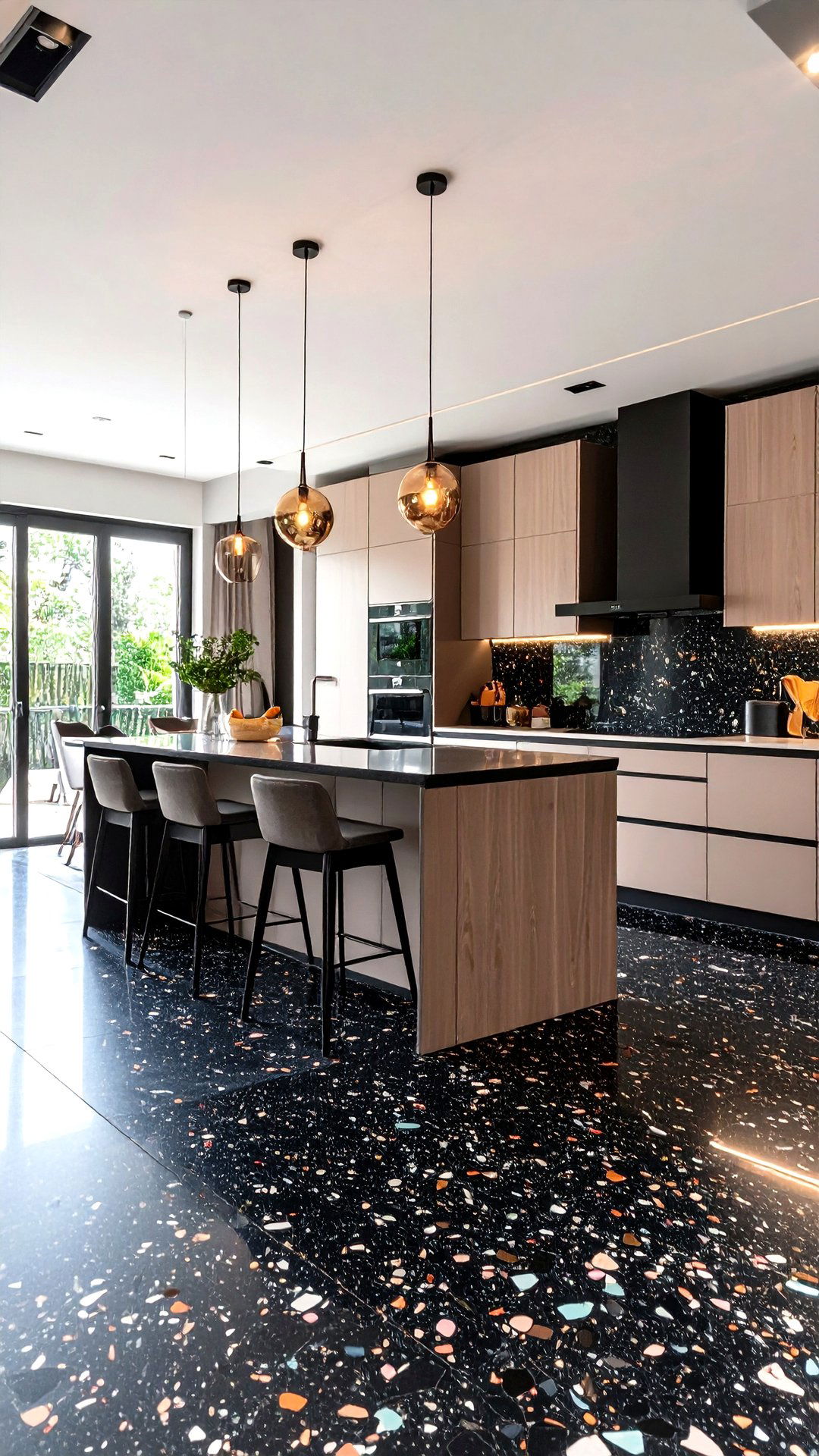
Looking for limitless personality? Choose a black terrazzo floor kitchen sprinkled with pastel chips — think blush, mint, and ochre — for a playfully modern vibe. Terrazzo’s recycled content and lifelong durability tick sustainability boxes, while today’s premixed tiles skip the mess of on-site pours. Keep cabinetry neutral so the speckled surface steals the show, and bounce pendant lighting off the polished finish to animate every fragment. It’s a clever way to enjoy a black floor that refuses to feel austere.
6. Polished Concrete Loft Style
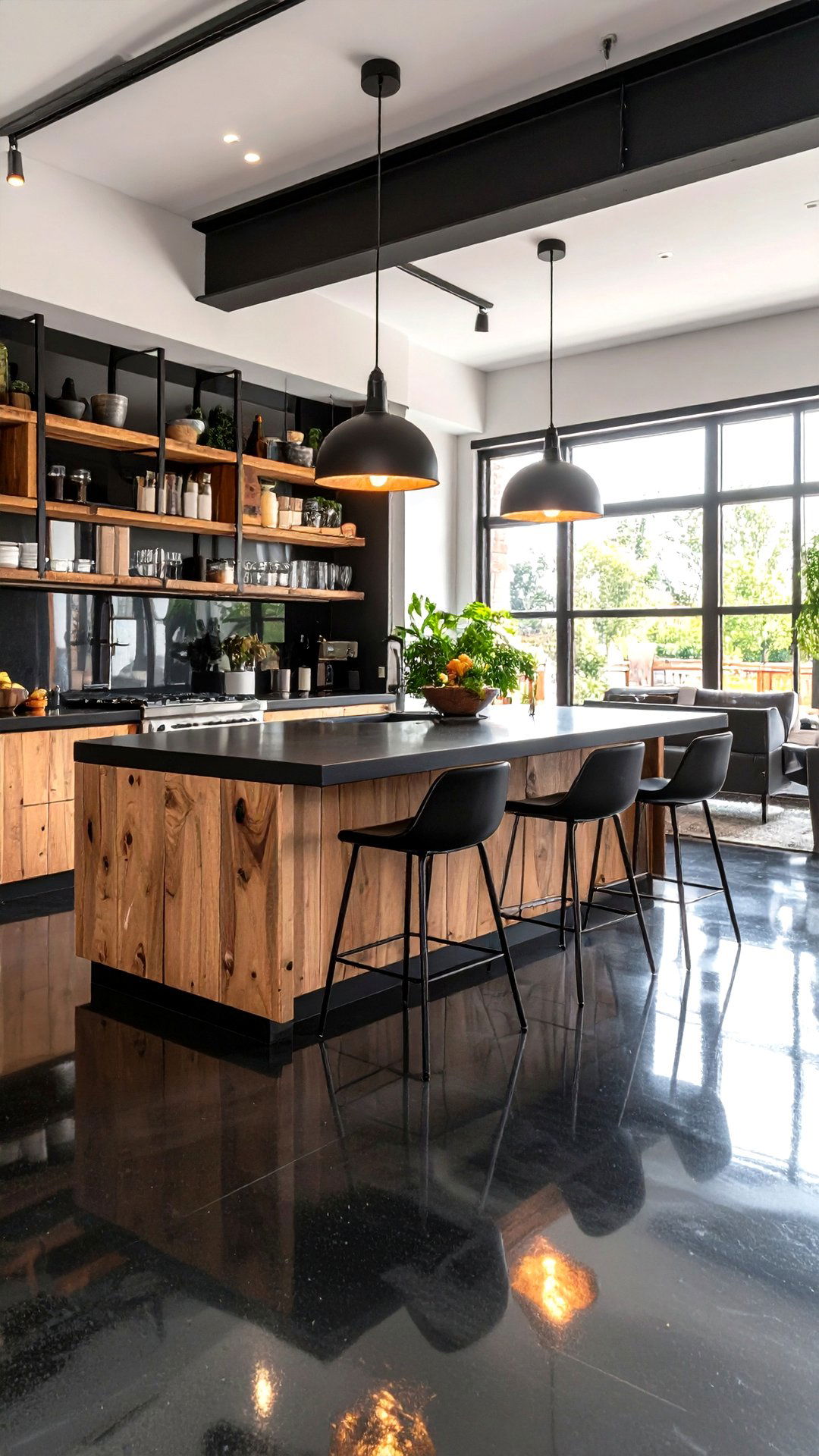
Few materials suit industrial lofts better than a black concrete slab burnished to a mirror gloss. Polishing densifies the surface, improving stain resistance, and the dark pigment disguises hairline cracks that naturally develop. A penetrating lithium sealer stops oils from etching while preserving the shimmering reflection. Layer with reclaimed timber shelving and matte-black steel stools to complete the warehouse vibe. The bonus: concrete’s thermal mass moderates indoor temperature, storing coolness on hot afternoons and releasing warmth in winter.
7. Budget-Friendly Vinyl Plank
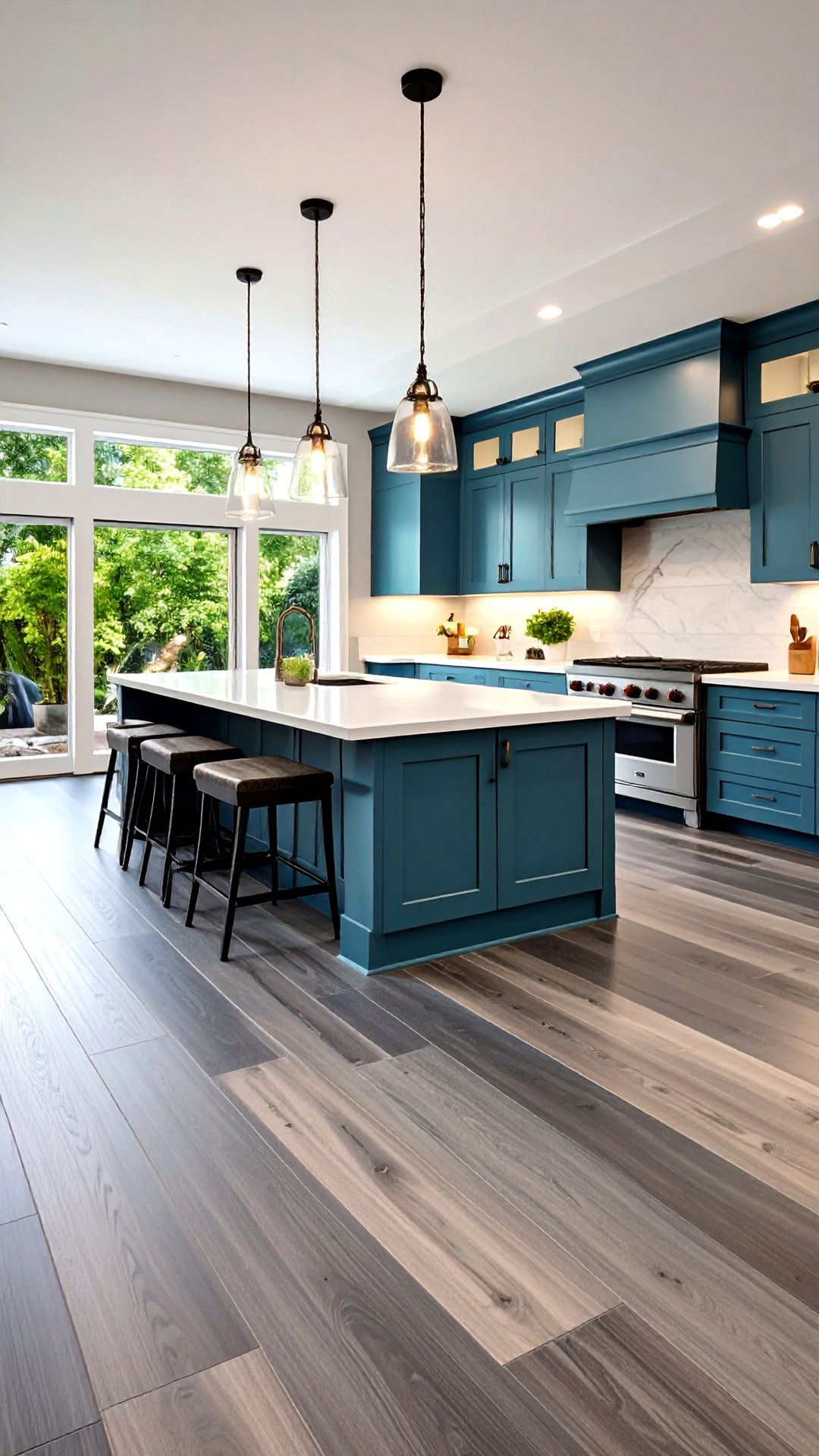
If renovation funds are tight, luxury vinyl plank (LVP) in a charcoal slate print offers believable texture with click-lock ease. Thicker 20-mil wear layers laugh off pet nails and toddler toys, while integrated pad backing hushes footfall in an open-concept black floor kitchen. Because vinyl is flexible, it tolerates modest subfloor imperfections and can float over existing tile — saving demolition costs. Choose long planks to reduce pattern repetition; the generous board length helps the faux stone read convincingly upscale.
8. Penny-Tile Punch
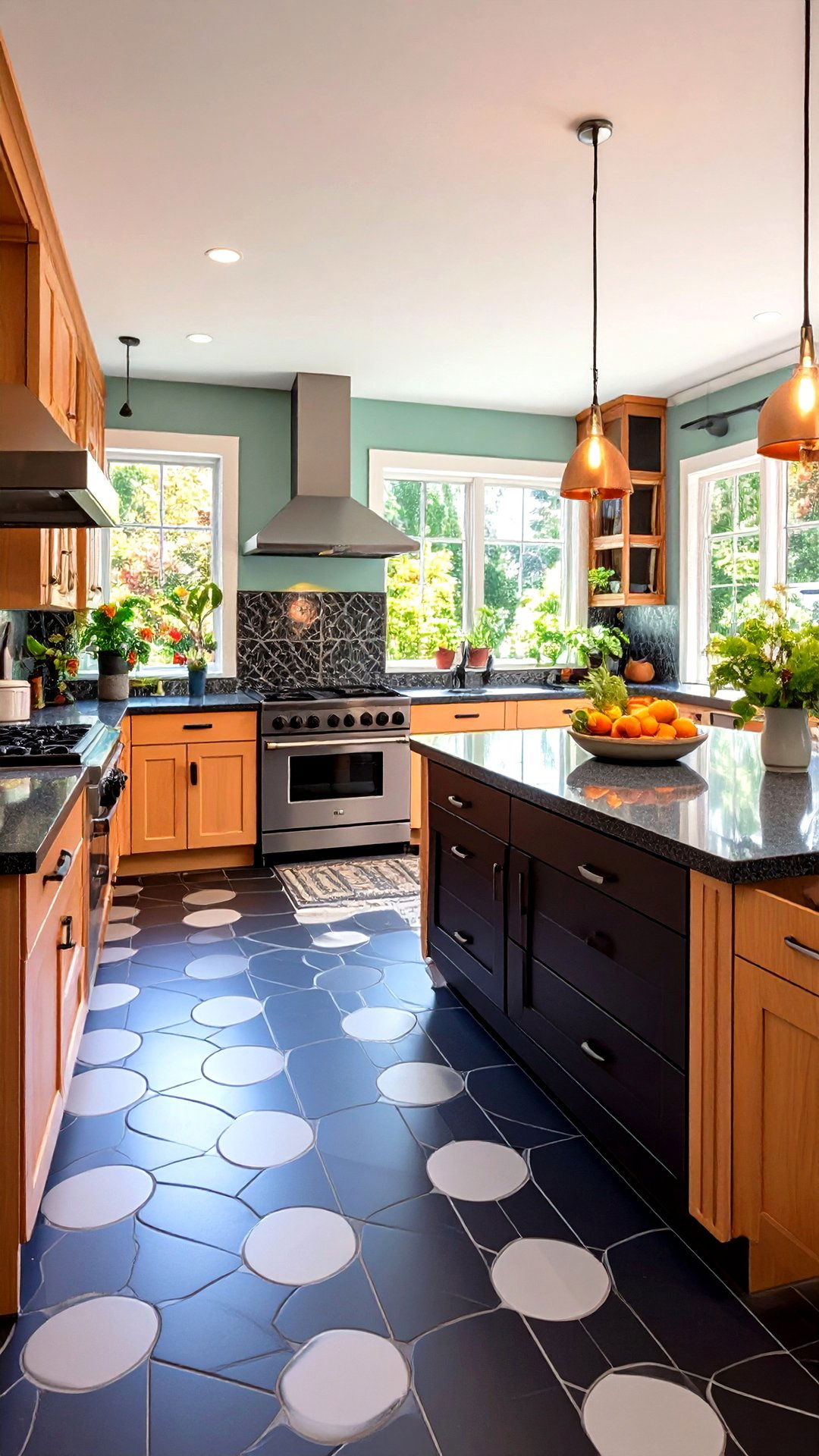
A carpet of tiny, round black porcelain penny tiles can make a compact galley kitchen feel curated and boutique. The grout grid creates built-in slip resistance, and you can play with contrasting grout colors — light gray adds definition, while matching black produces a velvety expanse. Consider inserting a stripe of white pennies as a playful runner down the center aisle. Because sheets arrive mesh-backed, installation stays DIY-friendly; just remember to seal grout lines annually for stain defense against coffee spills.
9. Seamless Porcelain Slabs
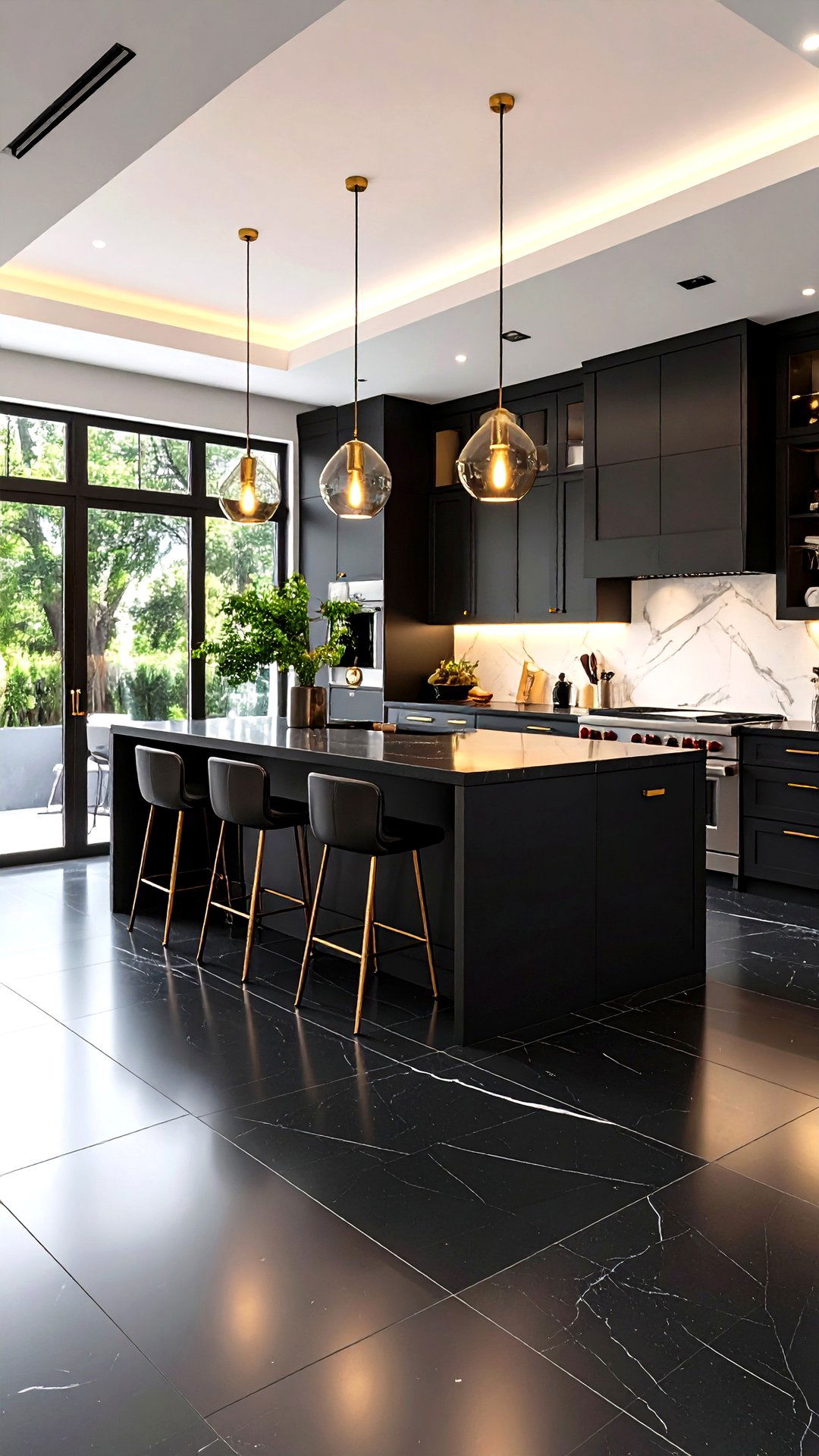
Oversized “gauged” porcelain panels — often 5 × 10 feet — erase grout entirely and deliver a monolithic black floor that mirrors upscale hotel lobbies. Despite their size, panels are only about 6 mm thick, keeping weight manageable over standard joists. Select a satin finish to withstand scuffs better than high-gloss, and pair with waterfall-edge countertops in matching slabs for cohesive luxury. Professional installers use specialized suction equipment, so budget for labor; the payoff is a kitchen floor so sleek it feels poured rather than tiled.
10. Wood-Inset Border Play
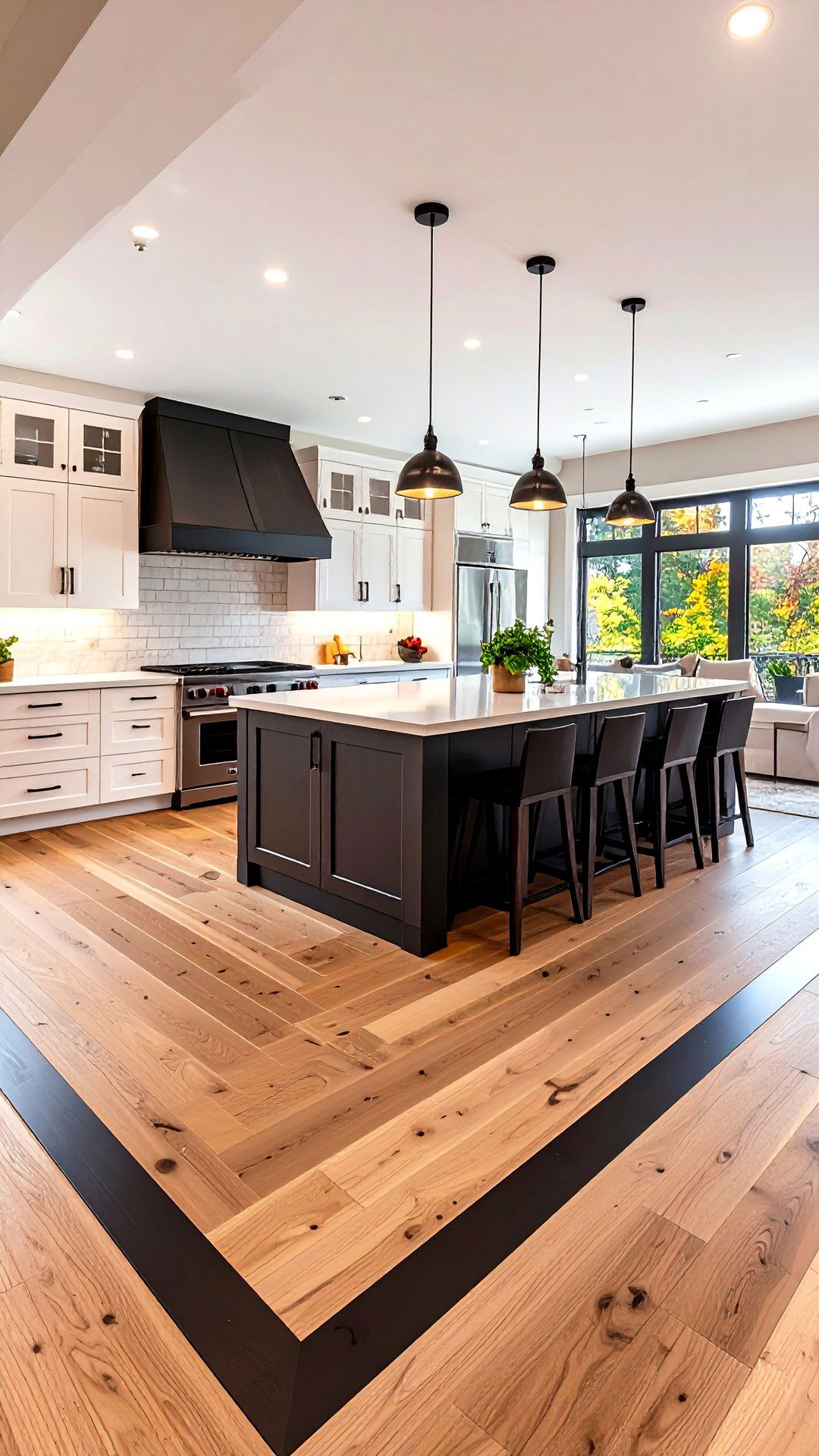
Blend warmth and depth by outlining a natural oak floor with a four-inch-wide black-stained perimeter band. The contrasting border frames the kitchen zone like a rug, helpfully defining cooking territory in open-plan homes. Use matching black thresholds at doorways so the accent reads intentional, not random. Finish the inner planks with a clear matte sealant and the border with extra-durable polyurethane to handle fridge rollouts. This idea satisfies anyone torn between lighter woods and striking dark flooring.
11. Hexagonal Geometry
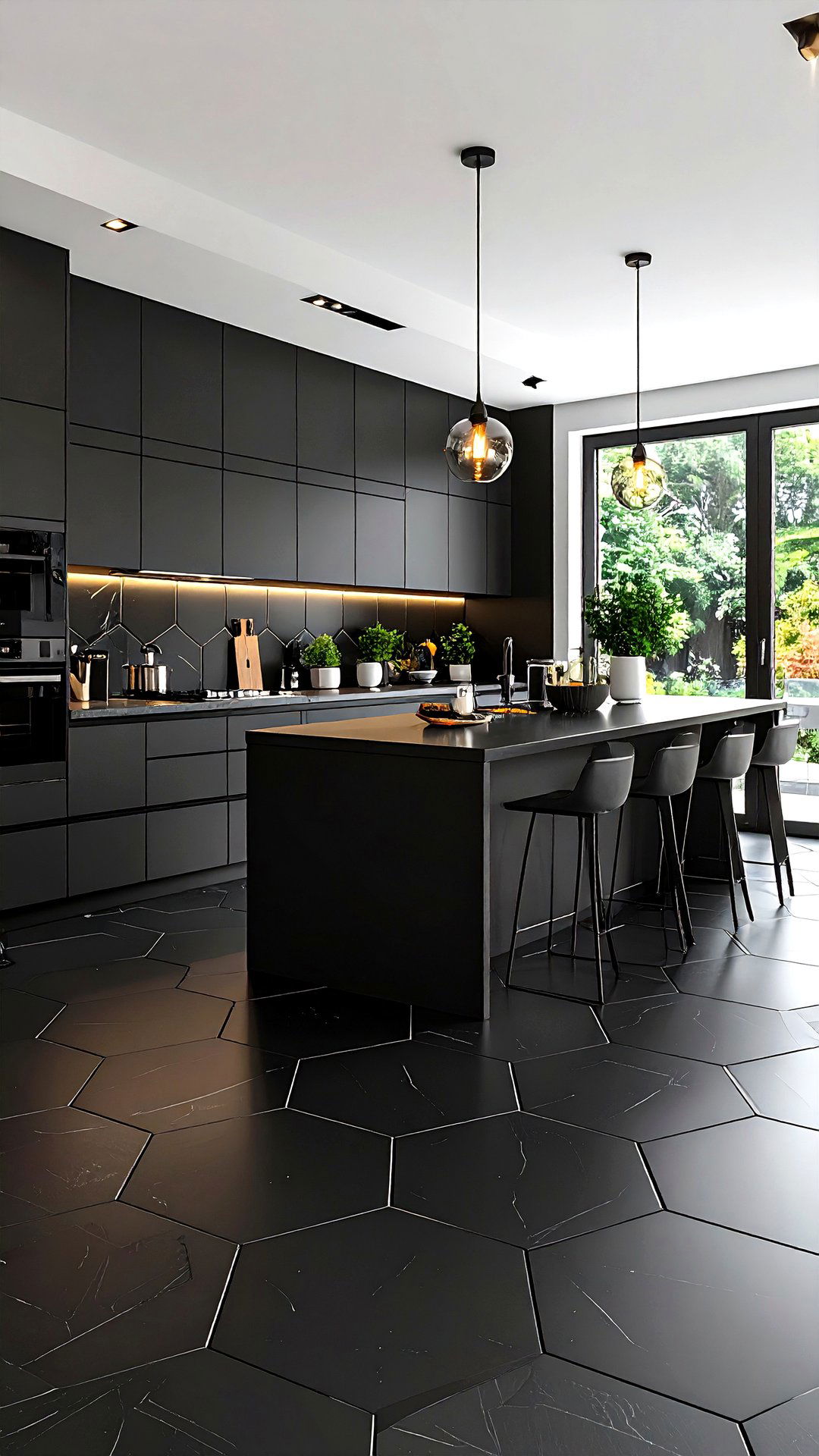
Large matte-black hex tiles — 12 inches across — create bold geometry that nods to honeycomb patterns popping up in 2025 backsplashes. The six-sided shape naturally minimizes visible repeats while directing the eye outwards, making tight kitchens feel broader. Break up the dark field with one random pale-gray hex every few feet for subtle sparkle, or keep things monochrome and let cabinet hardware provide shine. Because edges are beveled, dirt collects in grout lines less, making sweeping simpler.
12. Brass-Fleck Terrazzo Glam
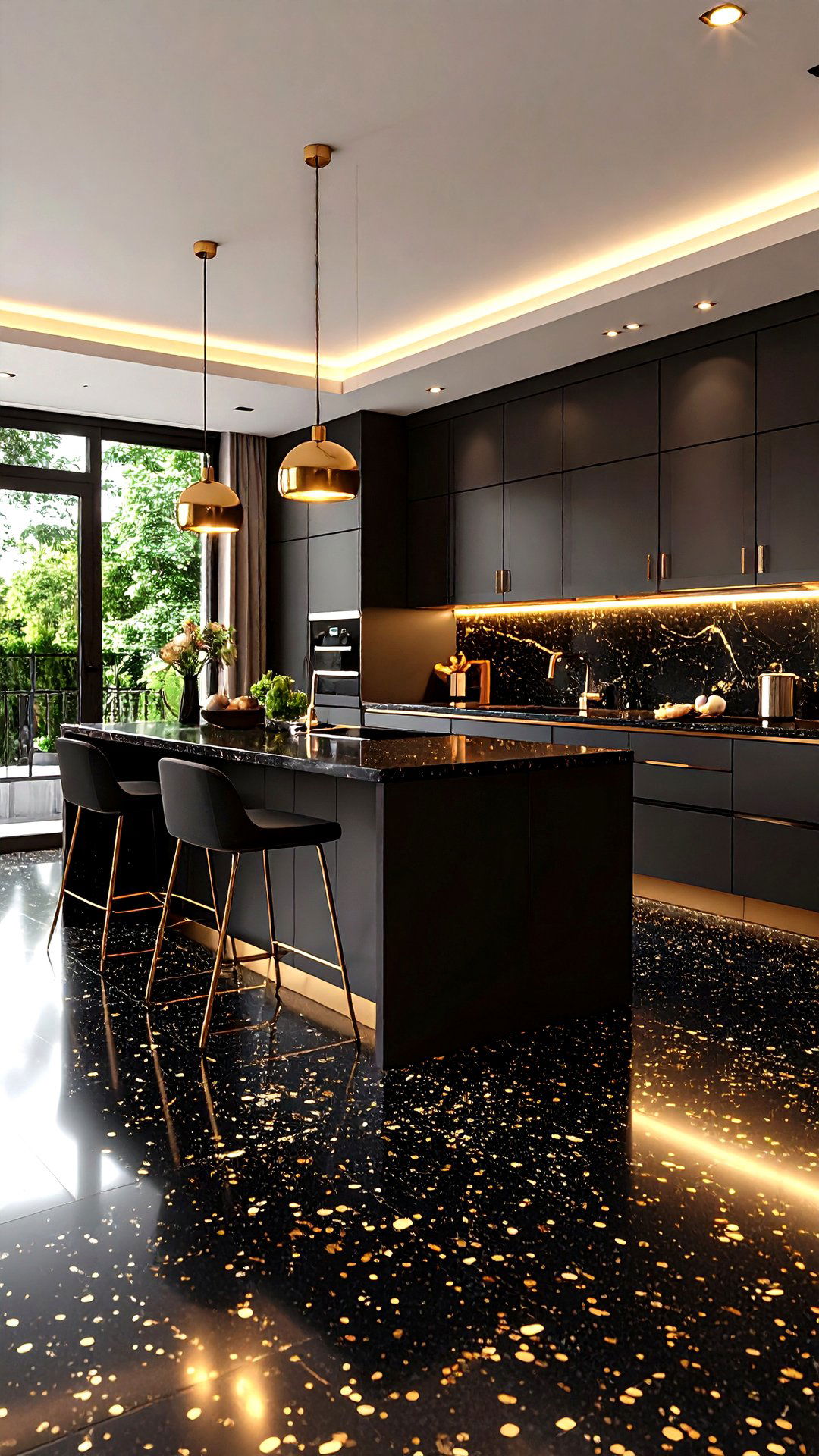
Add evening-wear elegance by specifying a black terrazzo mix tossed with recycled brass shavings. When polished, the metallic specks glimmer like confetti under downlights, turning the floor into functional jewelry. Pair with matte-black cabinets sporting satin-brass pulls to pick up the flecks. A water-based acrylic sealer preserves the metal’s warm tone without yellowing the matrix. This luxe black floor kitchen idea feels especially striking in small apartment layouts where the floor must double as visual art.
13. Rustic Slate & Radiant Heat
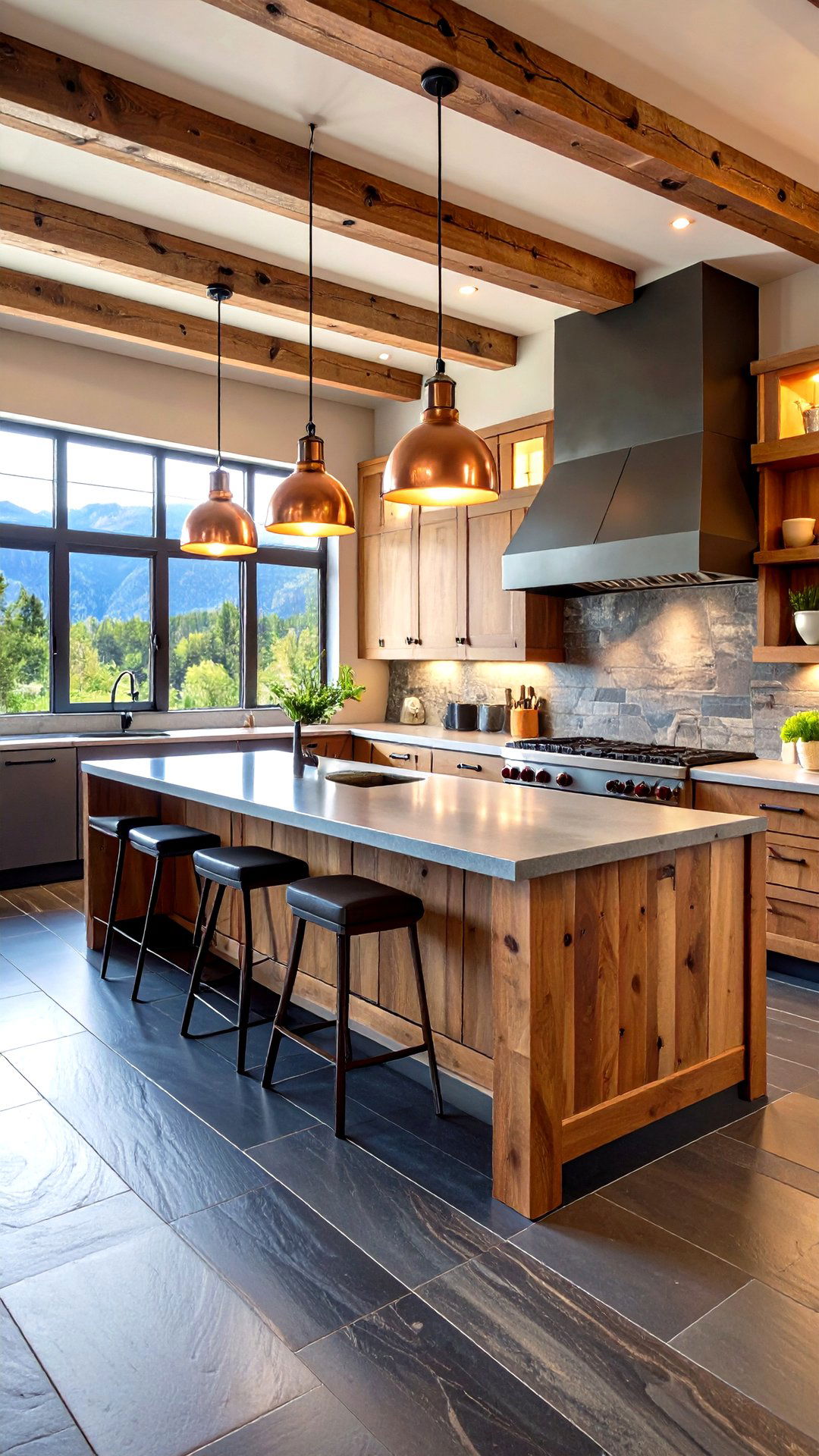
Textured riven slate in charcoal packs both grip and character, ideal for mud-clinging northern climates. Because natural clefts can feel chilly, embedding electric radiant mats beneath ensures the black floor kitchen stays comfortable during winter breakfasts. Finish seams with dark gray epoxy grout to withstand temperature swings better than cement-based versions. Rustic reclaimed-beam shelves and hammered-copper pendants echo slate’s rugged origins without slipping into farmhouse cliché.
14. Chevron-Pattern Engineered Wood
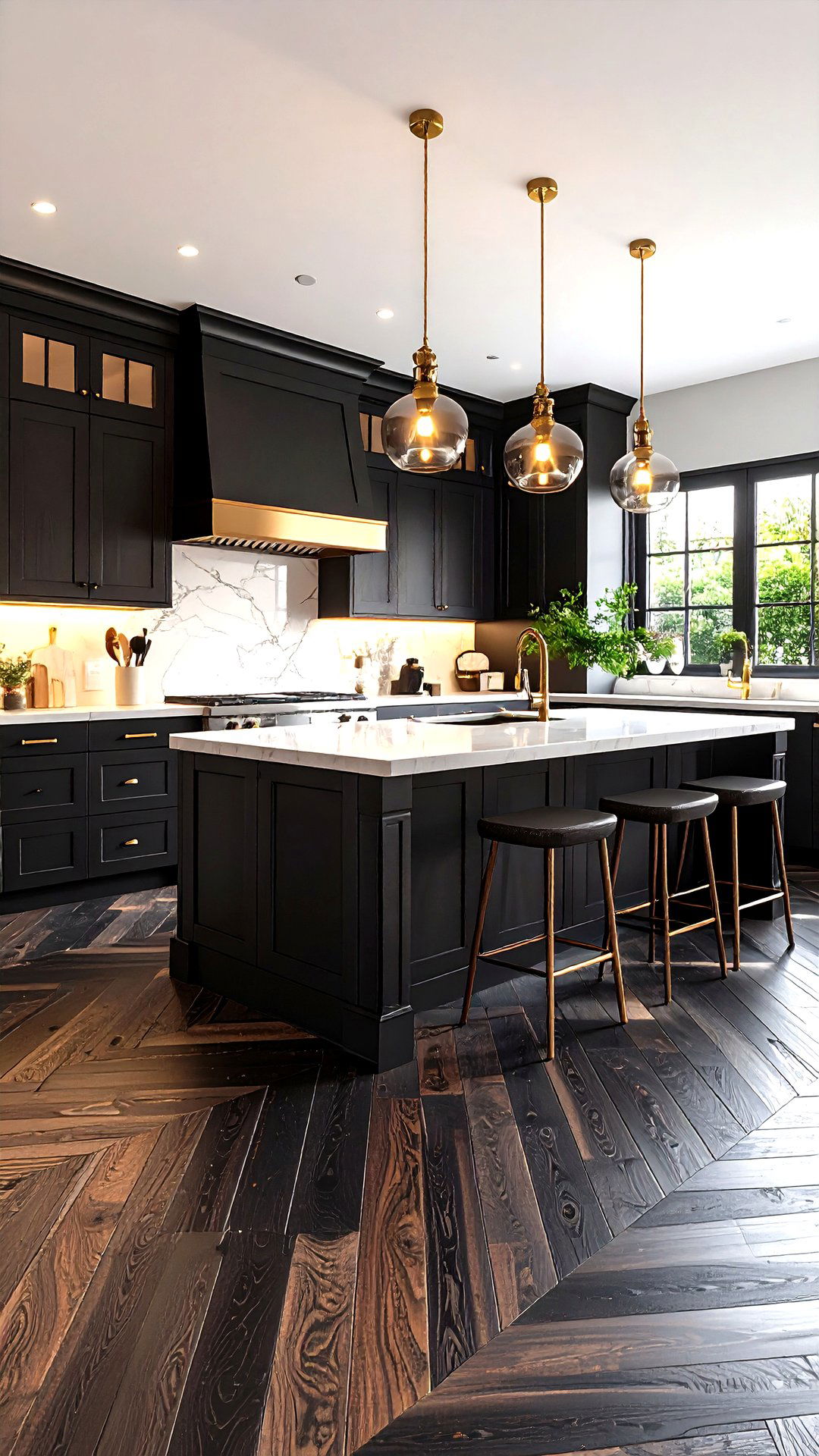
Engineered European oak planks, stained deep onyx and laid in a continuous chevron, bring Parisian apartment flair while tolerating humid kitchens better than solid wood. The symmetrical V pattern elongates sightlines, directing attention toward statement range hoods or garden views. Apply a low-VOC hard-wax oil; it lets grain show through the black tint and is spot-repairable if a dropped pan bruises the surface. Add cream stone counters and unlacquered brass taps for understated elegance.
15. Textured Anti-Slip Ceramic

Families with spirited kids know slip resistance is non-negotiable. Un-glazed ceramic tiles with a subtle linear texture scored across the black surface hit a safe R11 rating while still looking refined. The grooves run lengthwise, so place tiles perpendicular to foot traffic to maximize grip. Slightly bevelled edges keep cleaning tools from snagging, and a color-charged epoxy grout prevents the lines collecting grime. The result is a black floor kitchen ready for juice-box emergencies without sacrificing style.
16. Ombre Tile Transition
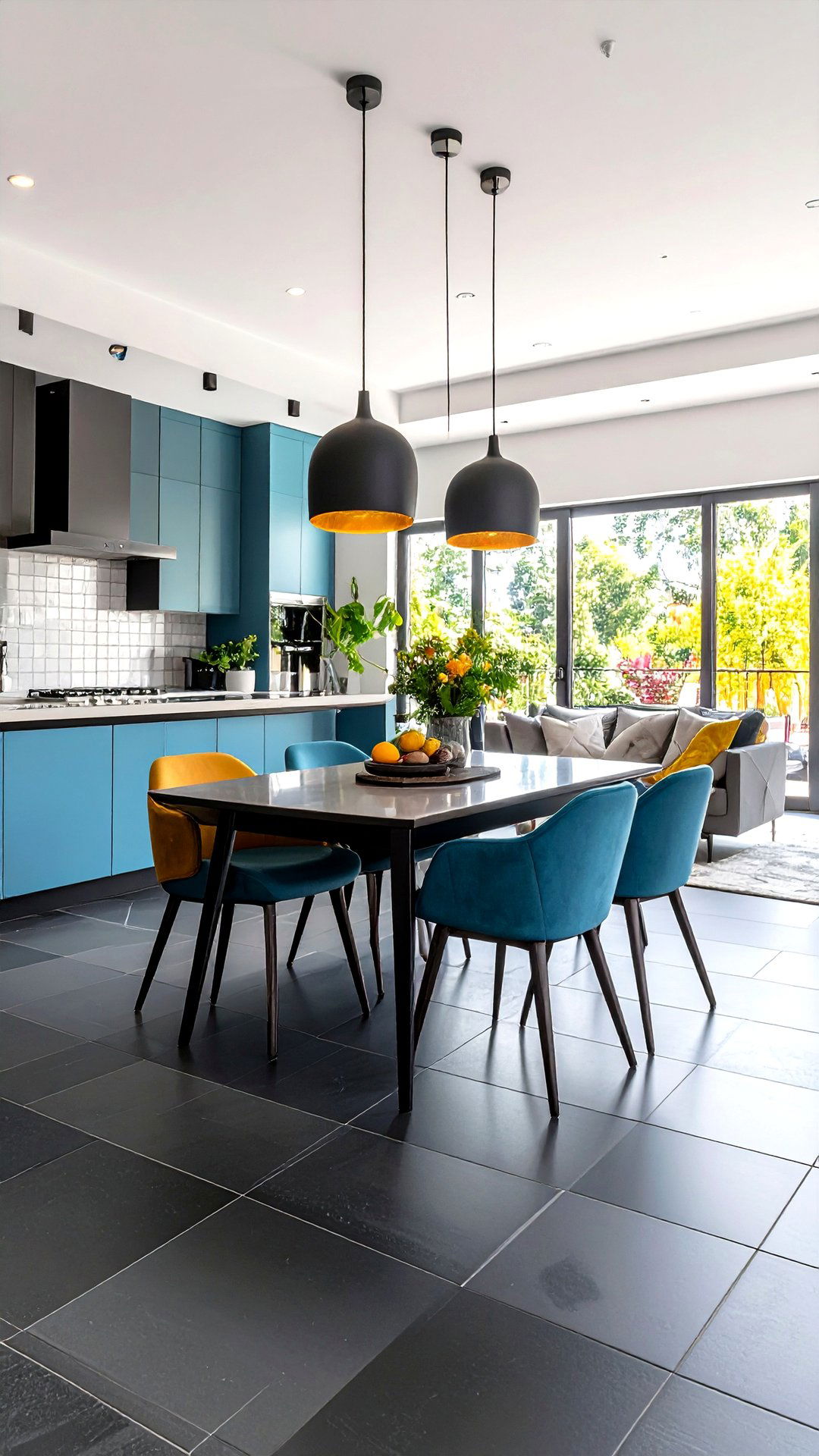
Create a smooth visual bridge between kitchen and living area by fading from dense black tiles at the cooking zone to mid-gray, then pale dove near seating. Manufacturers now sell gradient tile collections that simplify selection; install darkest to lightest away from windows so sunlight naturally amplifies the fade. This ombre black floor kitchen trick subtly zones activities without physical barriers or rug clutter. Underfoot, the color shift hides dirt as it migrates toward high-traffic thresholds.
17. Encaustic Cement Storyboard
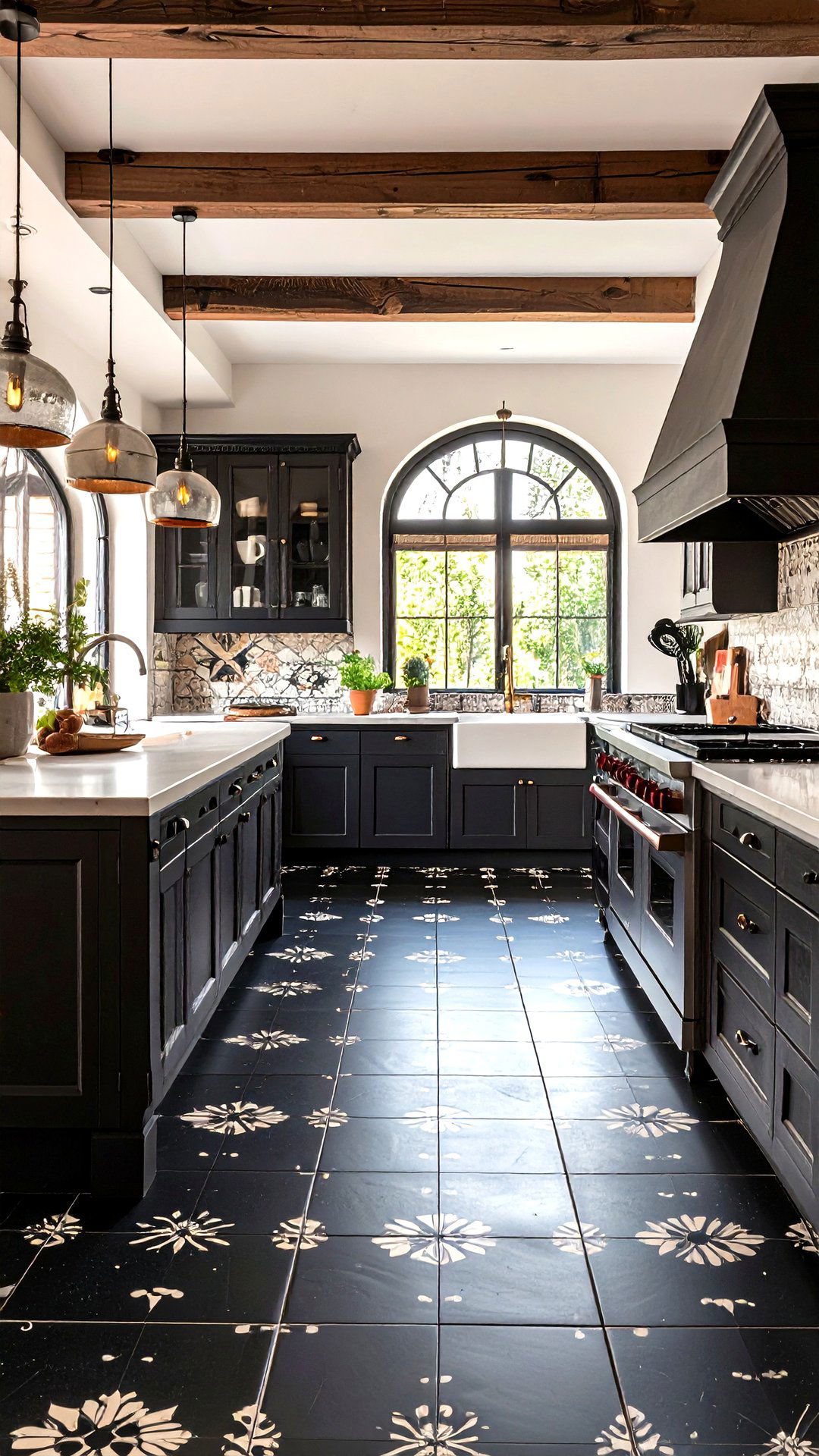
Hand-poured encaustic tiles allow you to embed white or clay motifs into a black base, delivering artisanal character underfoot. Patterns like Moroccan stars or Art Deco fans read especially crisp against ebony pigment. Cement needs sealing, but the payoff is a velvety matte surface that ages gracefully. Use plain black perimeter tiles around a decorative center panel for a “rug” effect that directs guests toward an island or breakfast nook. Encaustic’s ¾-inch thickness also deadens noise.
18. High-Gloss Epoxy Mirror
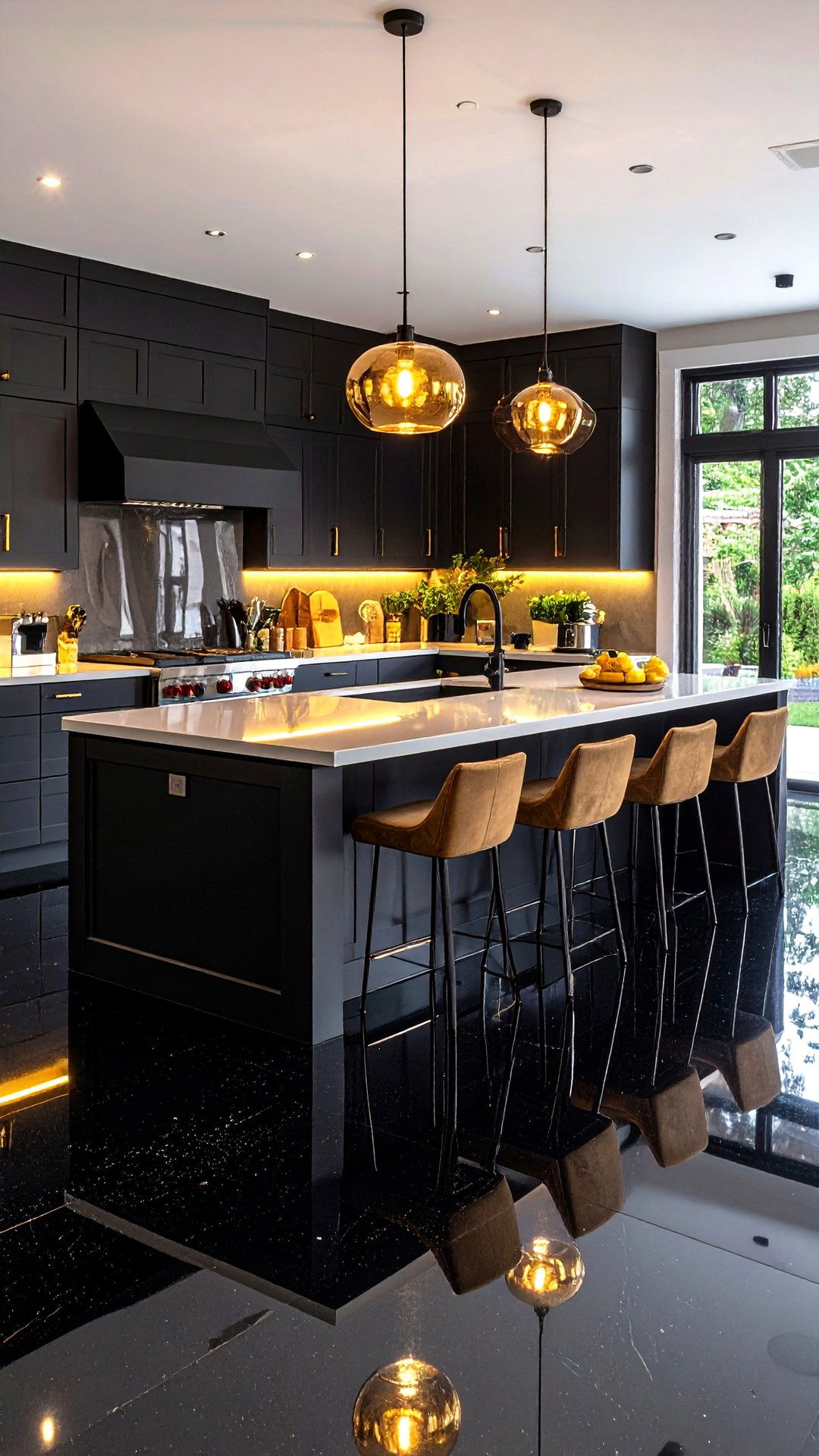
If you crave reflective drama, roll a pigmented two-part epoxy across primed subflooring, then finish with a clear flood coat. The resulting black mirror doubles images of pendant lights, visually raising ceilings. Slip-resistant additives keep safety in check without clouding the gloss. Because epoxy is seamless, cleaning is a single swoop; however, commit to felt pads under stool legs to ward off micro-scratches. Ideal for contemporary black floor kitchens where statement lighting takes center stage.
19. Eco-Smart Rubber Underfoot
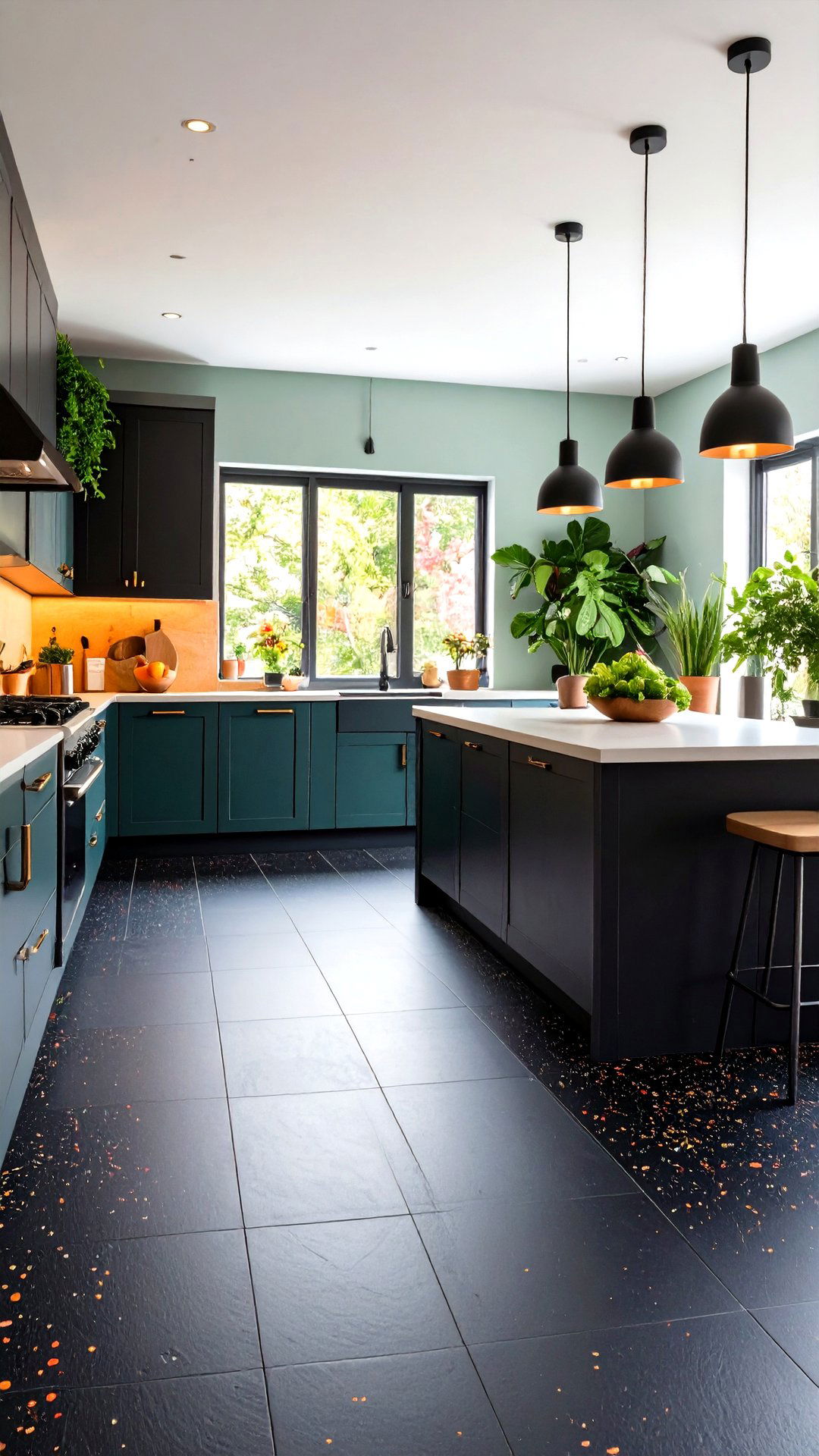
Recycled rubber flooring — often reclaimed from car tires — comes in deep charcoal sheets that cushion joints during long cooking sessions. Speckling in colored flecks hides crumbs and introduces playful accents. Rubber is naturally water-resistant and quiet, making it a black floor kitchen win for multitasking parents. Finish edges with welded seams rather than metal strips for a commercial-grade seal. Mild soap keeps the matte surface looking sharp without requiring waxes or polish.
20. Oxide-Stained Concrete Cloud

Give straightforward concrete a painterly soul by applying a reactive iron-oxide stain that blooms smoky charcoal tones with subtle cloud-like swirls. The mottling disguises footprints and evolving patina, essential for households that love barefoot traffic. Seal with a breathable penetrating guard so moisture escapes, preventing whitening. Balance the organic floor with sleek handle-less cabinets and minimal décor — let the stained concrete supply all the visual depth a black floor kitchen needs.
21. Stone-Look Luxury Vinyl Tile
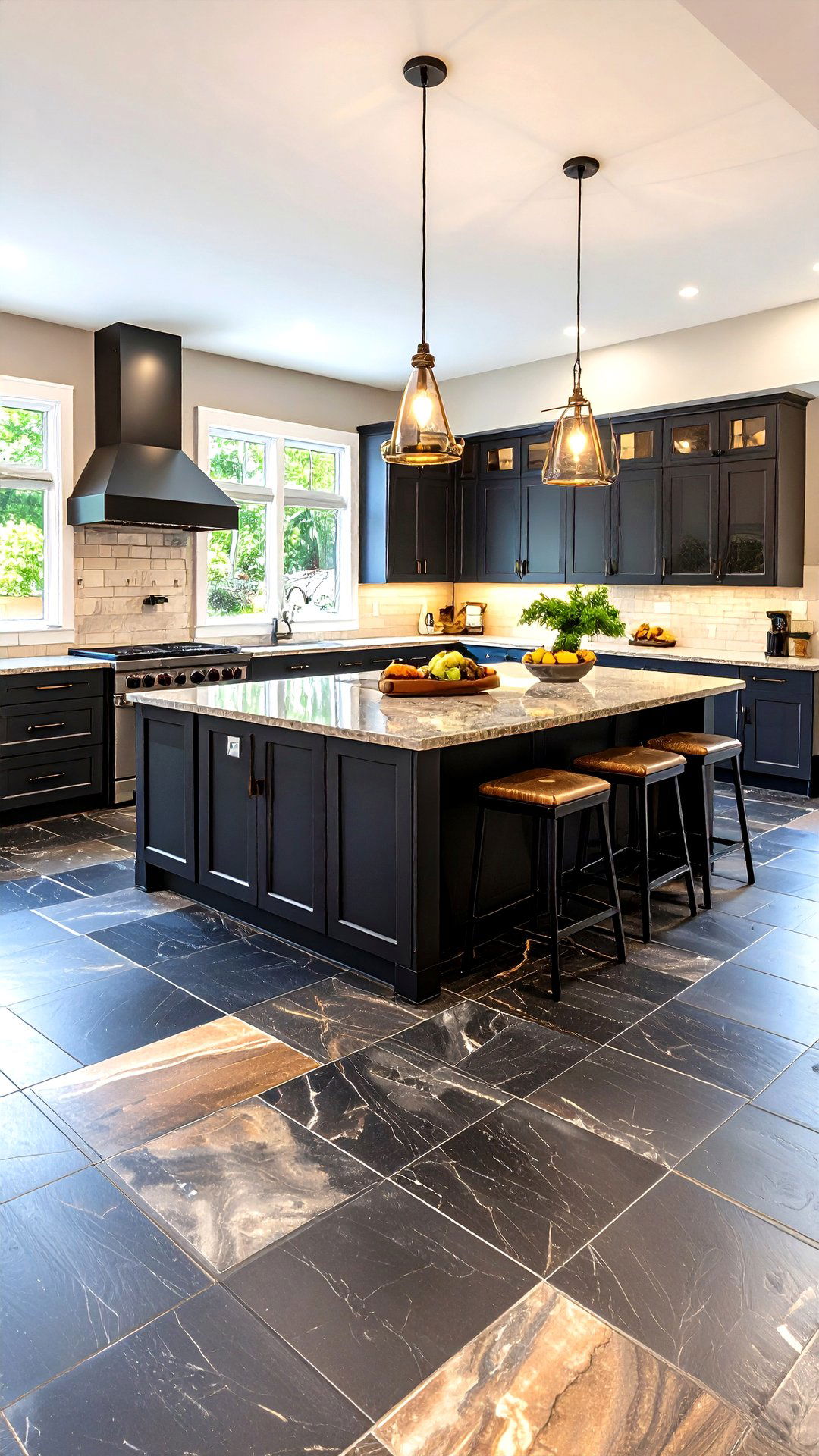
For renovators after stone drama minus chilly toes, luxury vinyl tile (LVT) printed in black travertine offers warmth and budget relief. Because pieces are square rather than planks, you can quarter-turn them for natural randomness. Add matching black silicone around the room’s perimeter instead of white quarter-round to preserve the illusion of real stone extending beneath cabinets. The cushioned core is forgiving when saucepans slip, making this black floor kitchen idea renter-friendly.
22. Gloss-and-Matte Mosaic Mix
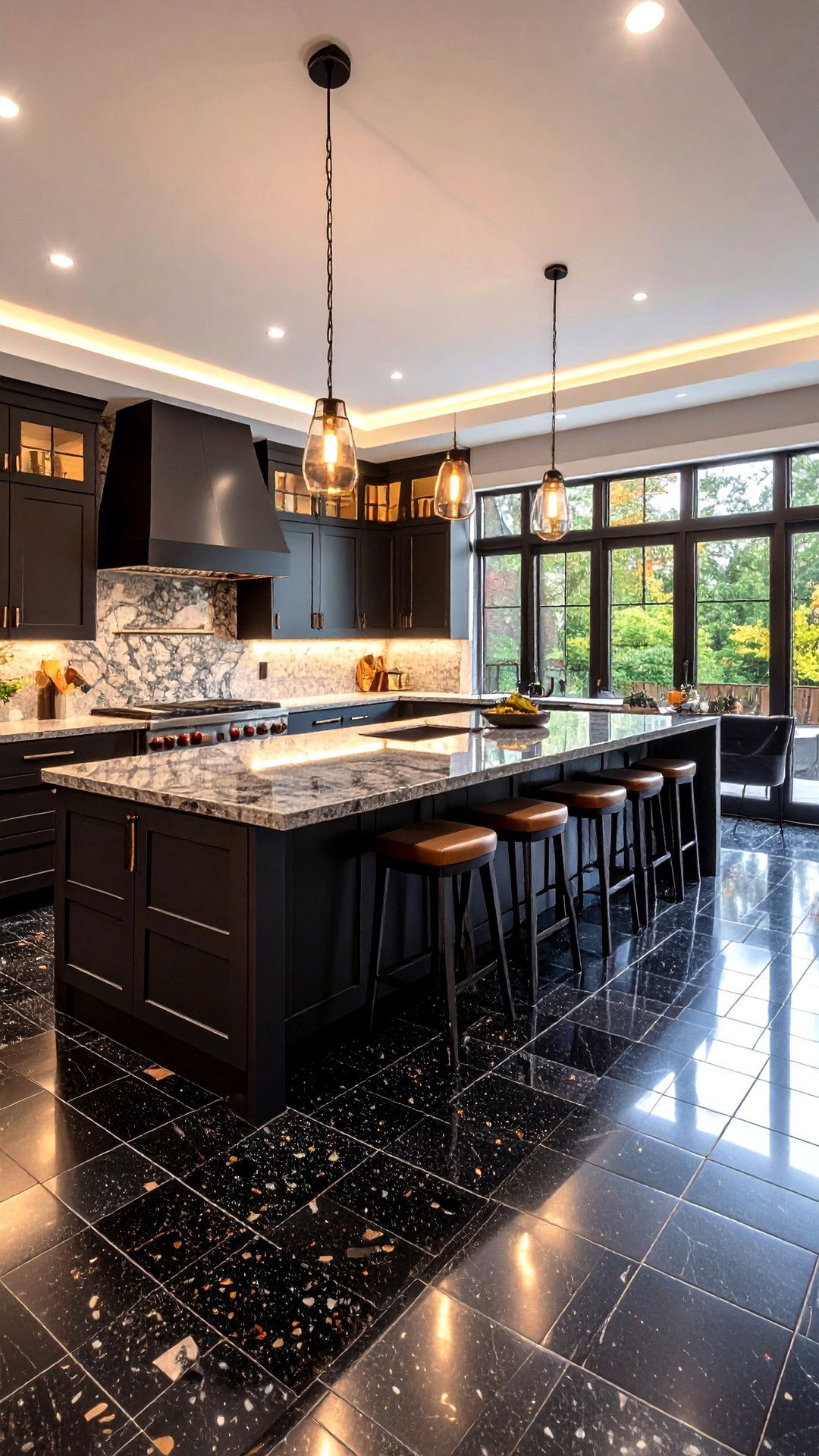
Combine shiny black glass mosaics with honed basalt chips in one sheet to produce a tactile checker of reflectivity. When under-cabinet LEDs skim across the surface, some squares twinkle while others recede, giving the floor changing moods from breakfast to midnight snack. Because grout lines are numerous, use stain-proof epoxy; its smooth finish resists pasta-sauce pigments. Keep wall treatments calm — think flat-panel oak — to avoid visual overload.
23. Microcement Overlay Ease
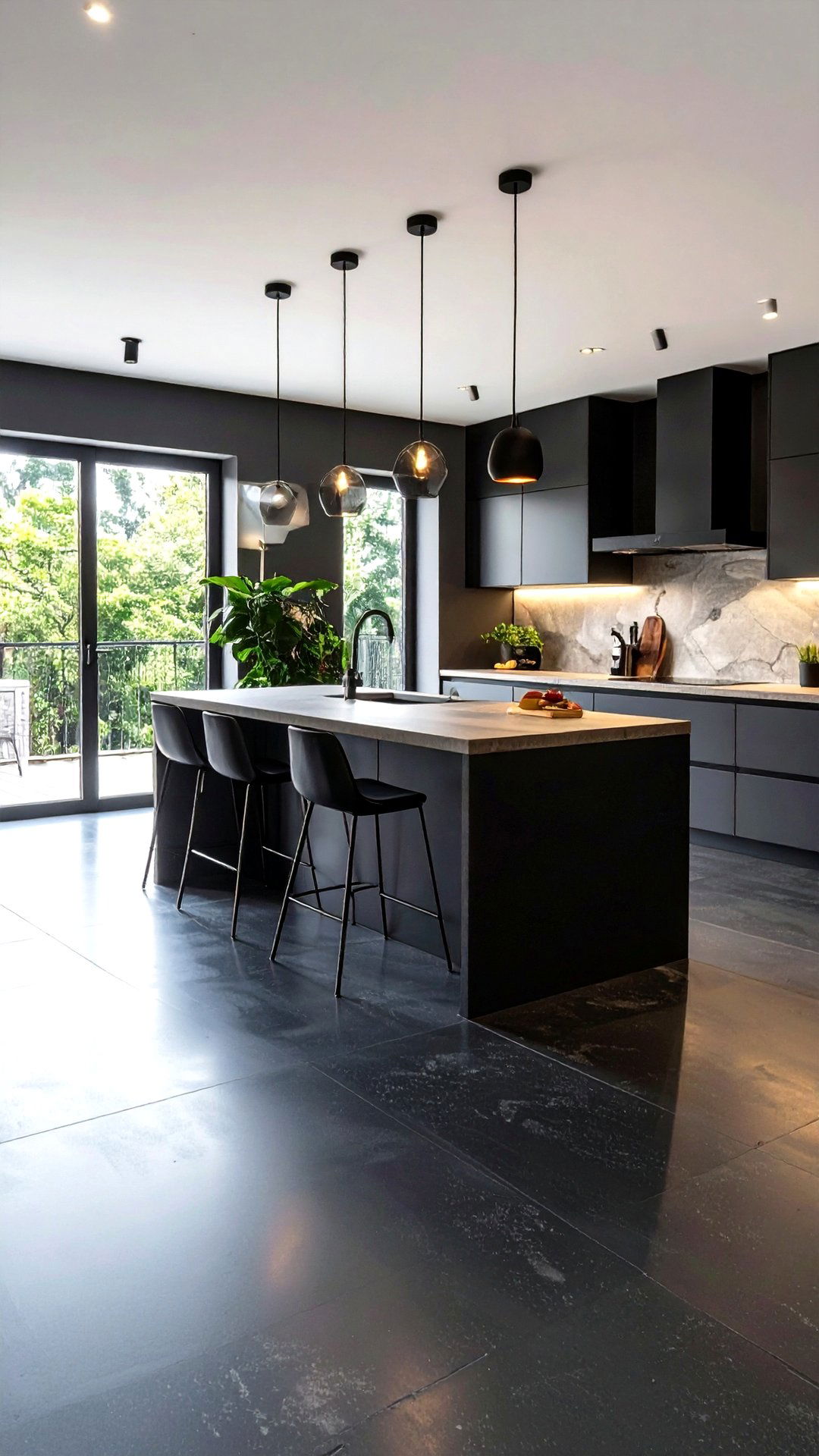
Microcement systems let you smooth a continuous charcoal skin over existing tile without demolition, ideal for swift makeovers. At only 3 mm thick, edges feather neatly into adjoining rooms. The hand-troweled finish shows artisanal strokes, softening black’s perceived heaviness. Add a matte polyurethane topcoat for stain guard and choose white oak shelves to offset the dark floor. This black floor kitchen idea is perfect when you want bespoke texture but not weeks of construction mess.
24. Pastel Pop Contrast
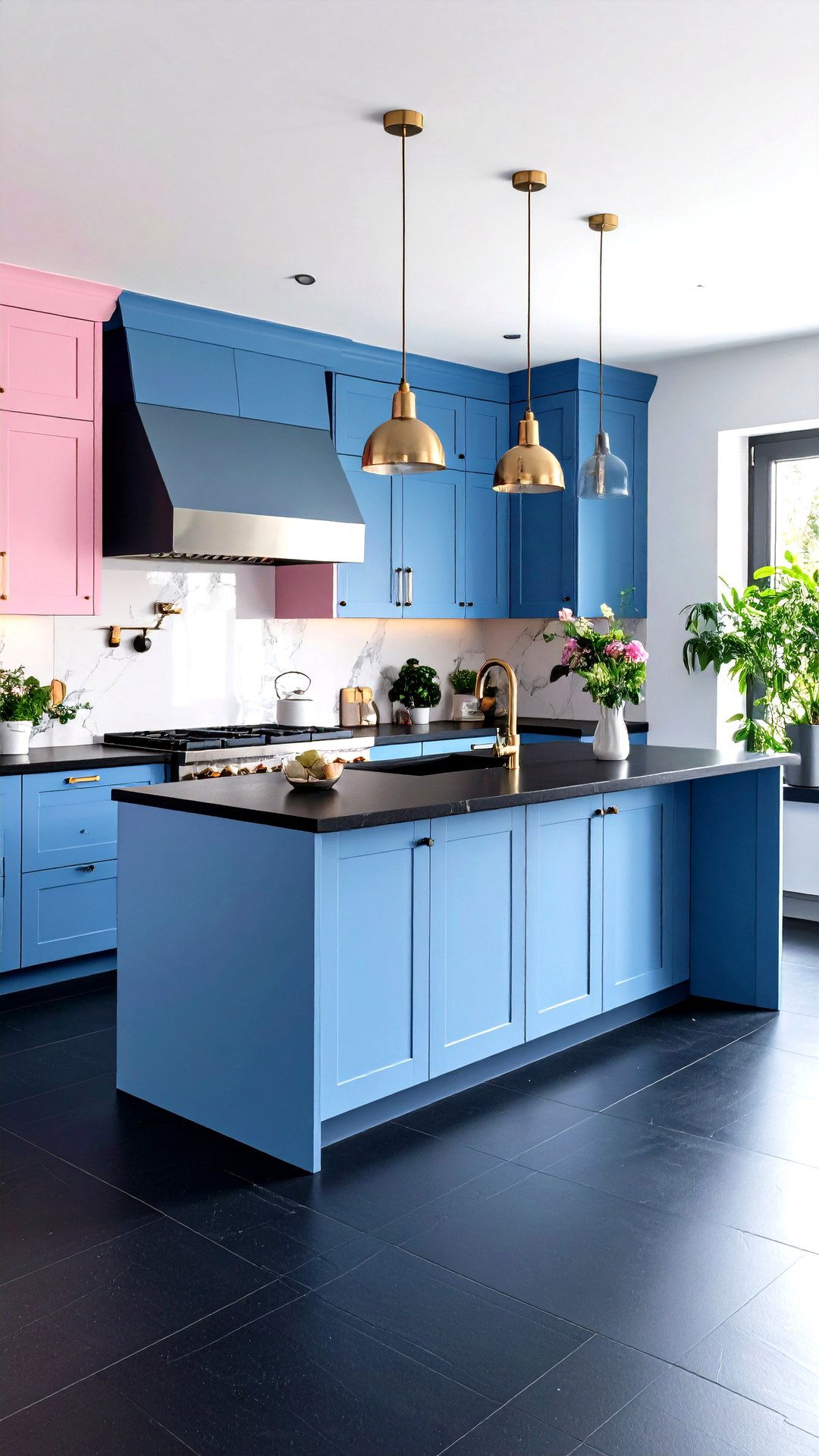
Paint cabinets sorbet pink or powder blue to intentionally clash against a jet-black floor; the high-contrast palette feels playful, not childish, when grounded by matte finishes. Use black quartz countertops to tie upper and lower zones together, stopping visual fragmentation. Because color draws the eye upward, the dark floor recedes, letting bold cabinetry shine. Swap out handles seasonally — brushed nickel in summer, leather pulls in winter — to refresh the look without altering the foundational black floor kitchen statement.
25. Metallic-Inlay Marble Tile
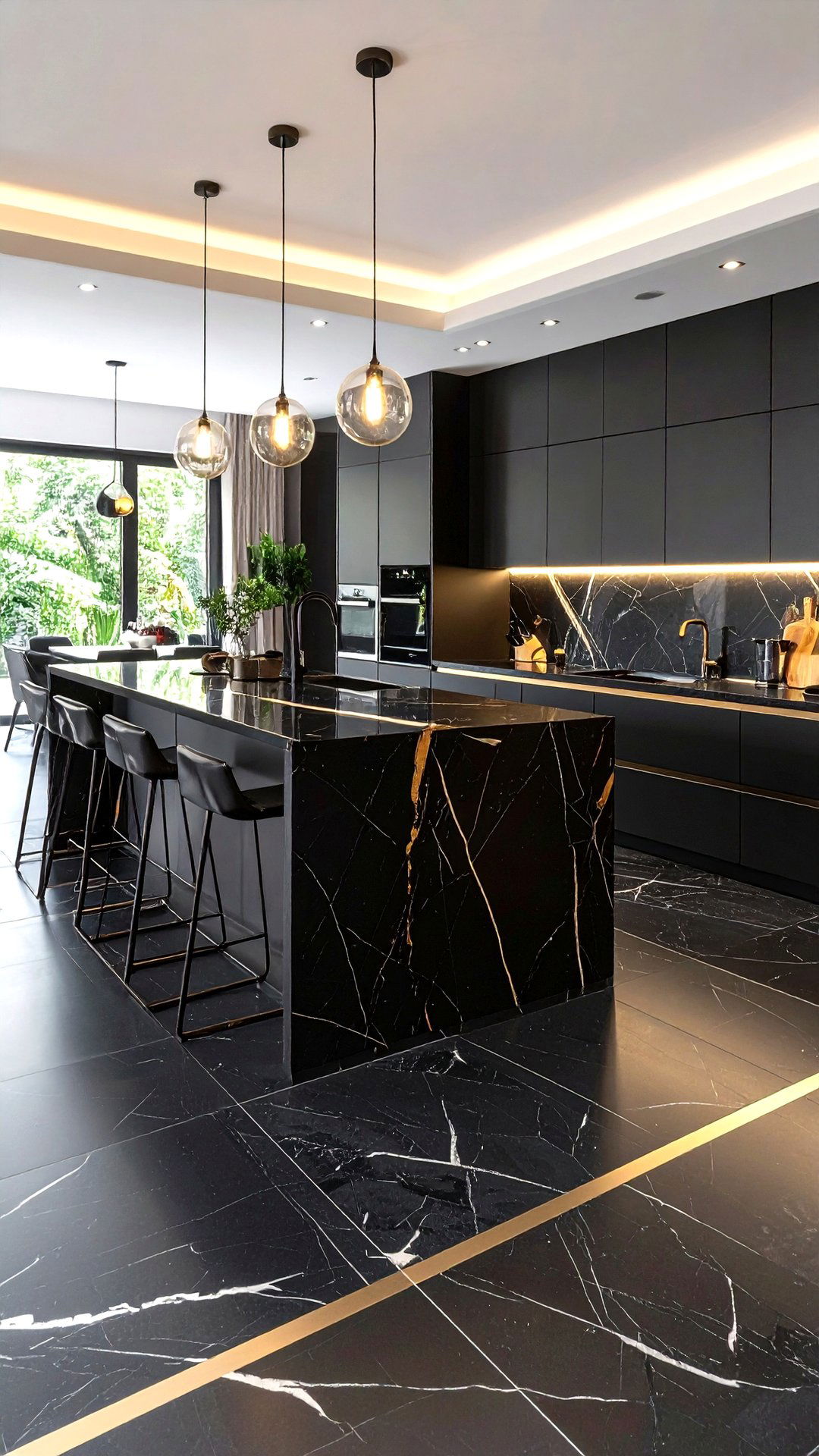
Elevate a traditional marble tile by specifying thin stainless-steel inlay strips set into grooved channels, framing each oversized 30-inch black marble square. The metallic lines bounce light across the dark stone and echo appliance finishes, giving cohesion. Install with minimal grout to maintain precision. Pairing this luxe floor with waterfall marble counters builds a sense of tailored opulence often reserved for boutique hotels — now right at home in your culinary workspace.
Conclusion:
From subtle slate that practically cleans itself to gleaming epoxy that mirrors pendant lights, a black floor kitchen can be whatever your lifestyle demands: rustic, glam, budget-wise, or daringly modern. The common thread is how decisively the ebony base anchors color, texture, and daily traffic, turning the room into a confident centerpiece rather than just another work zone. Use these 25 ideas as a roadmap and tailor the materials, patterns, and finishes to suit your cooking habits, climate, and personal flair — because the best black floor isn’t simply dark, it’s brilliantly you.


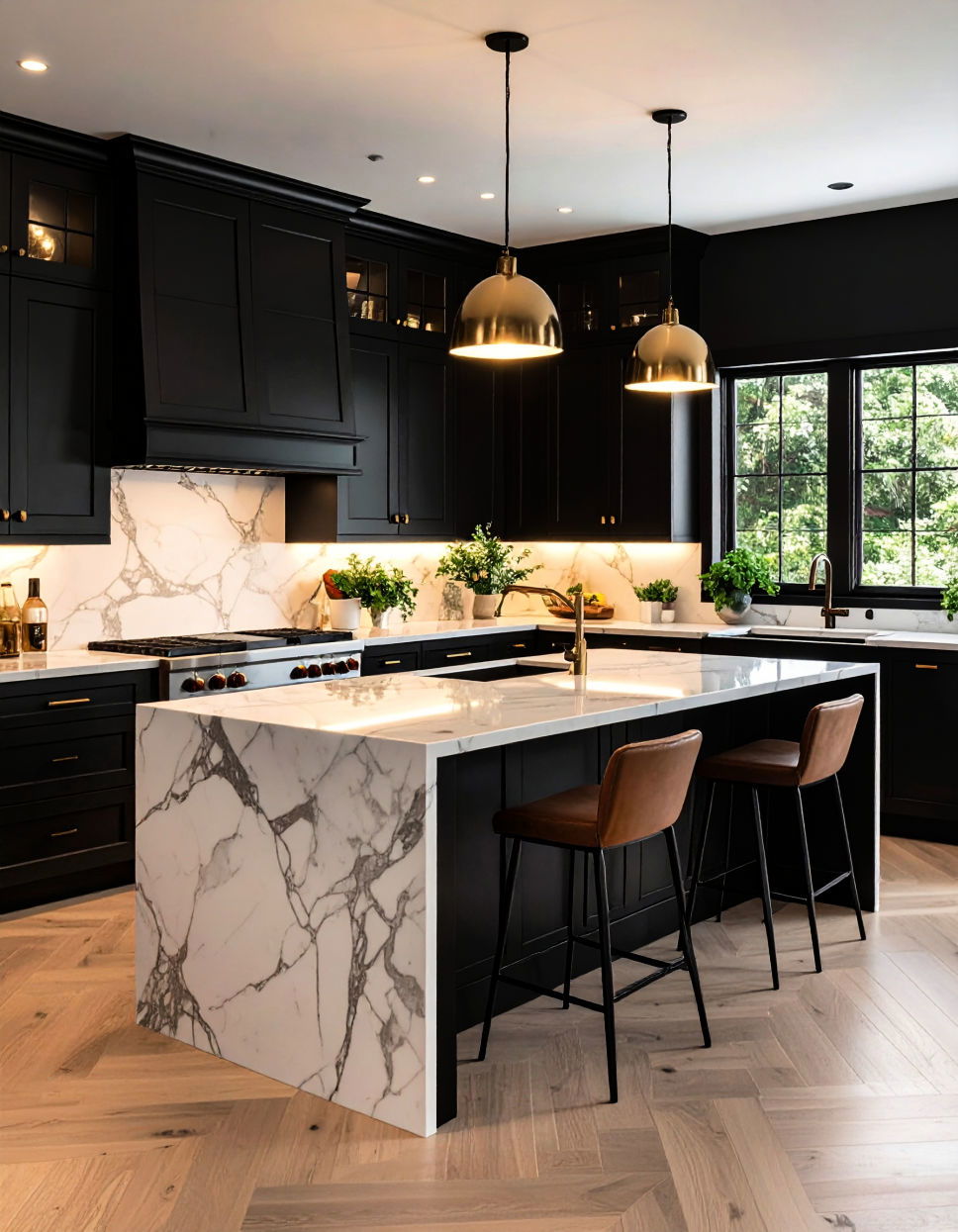

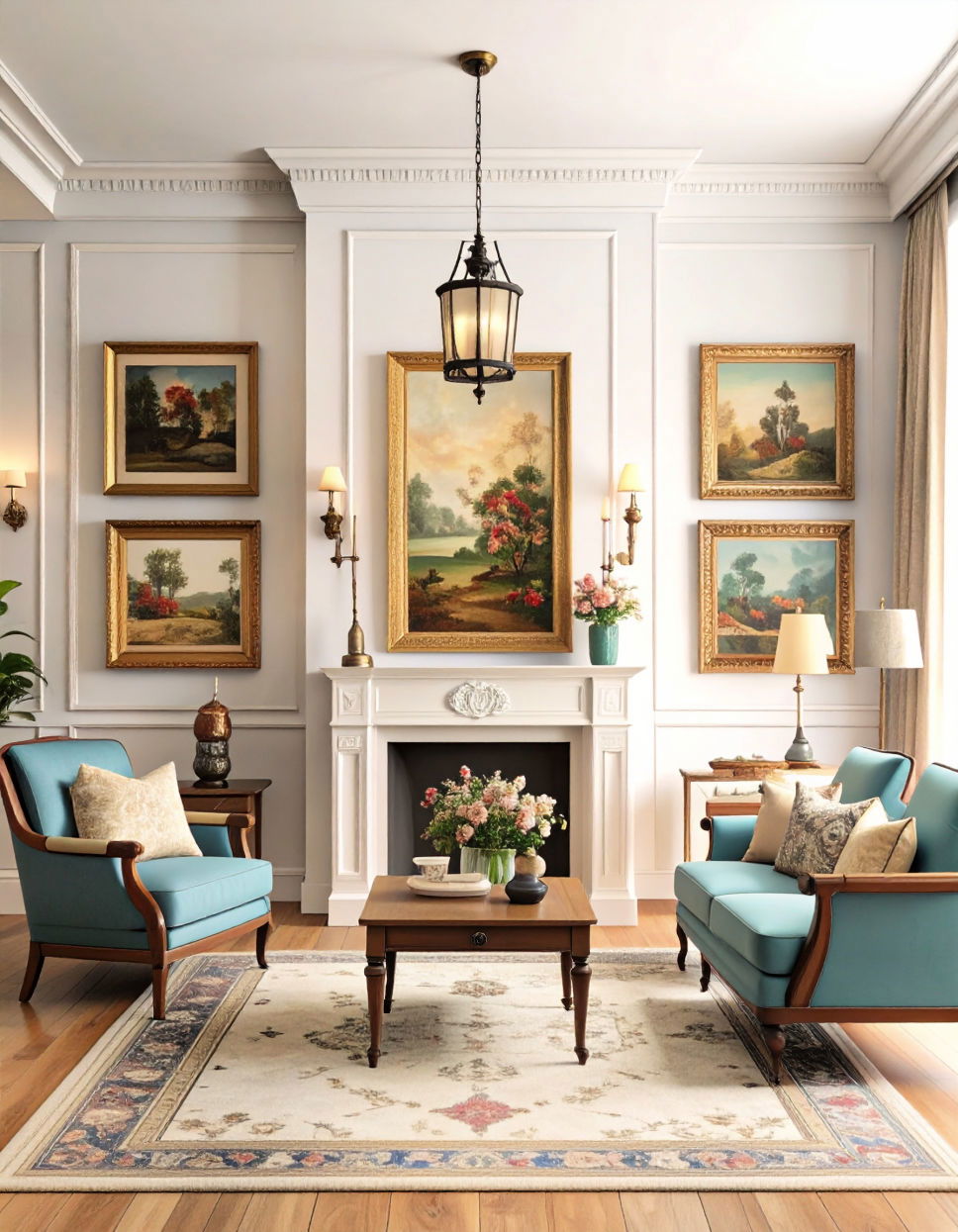
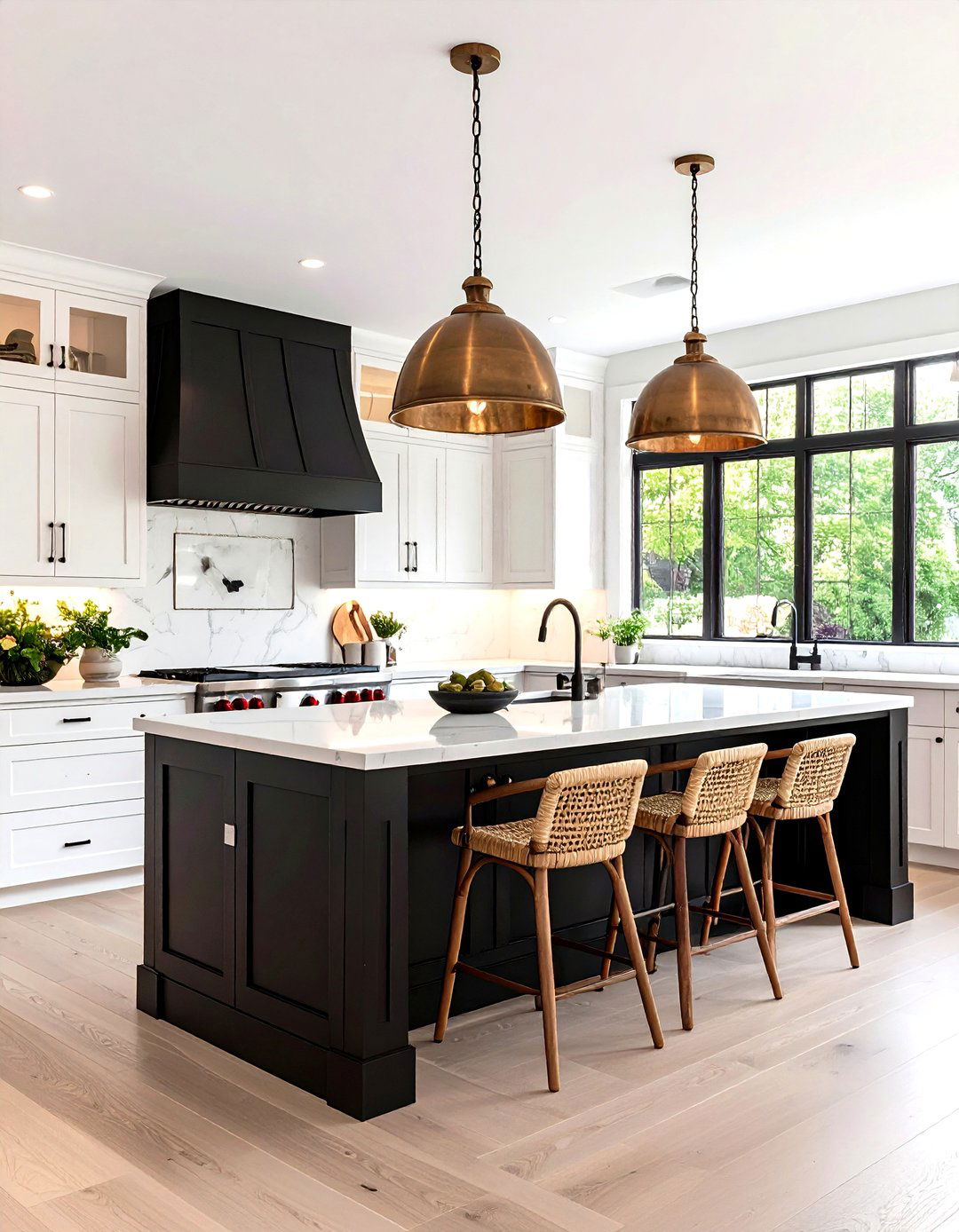
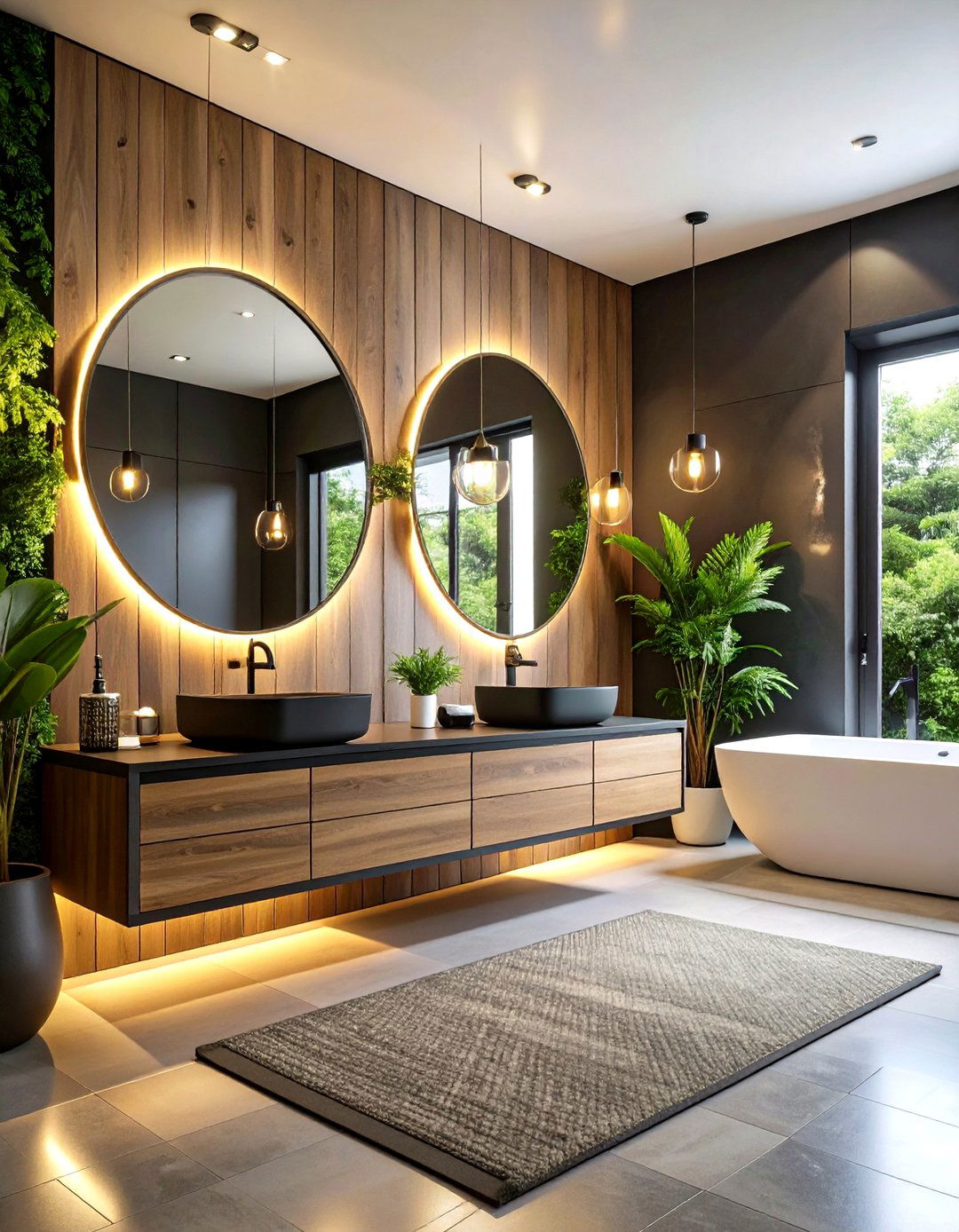
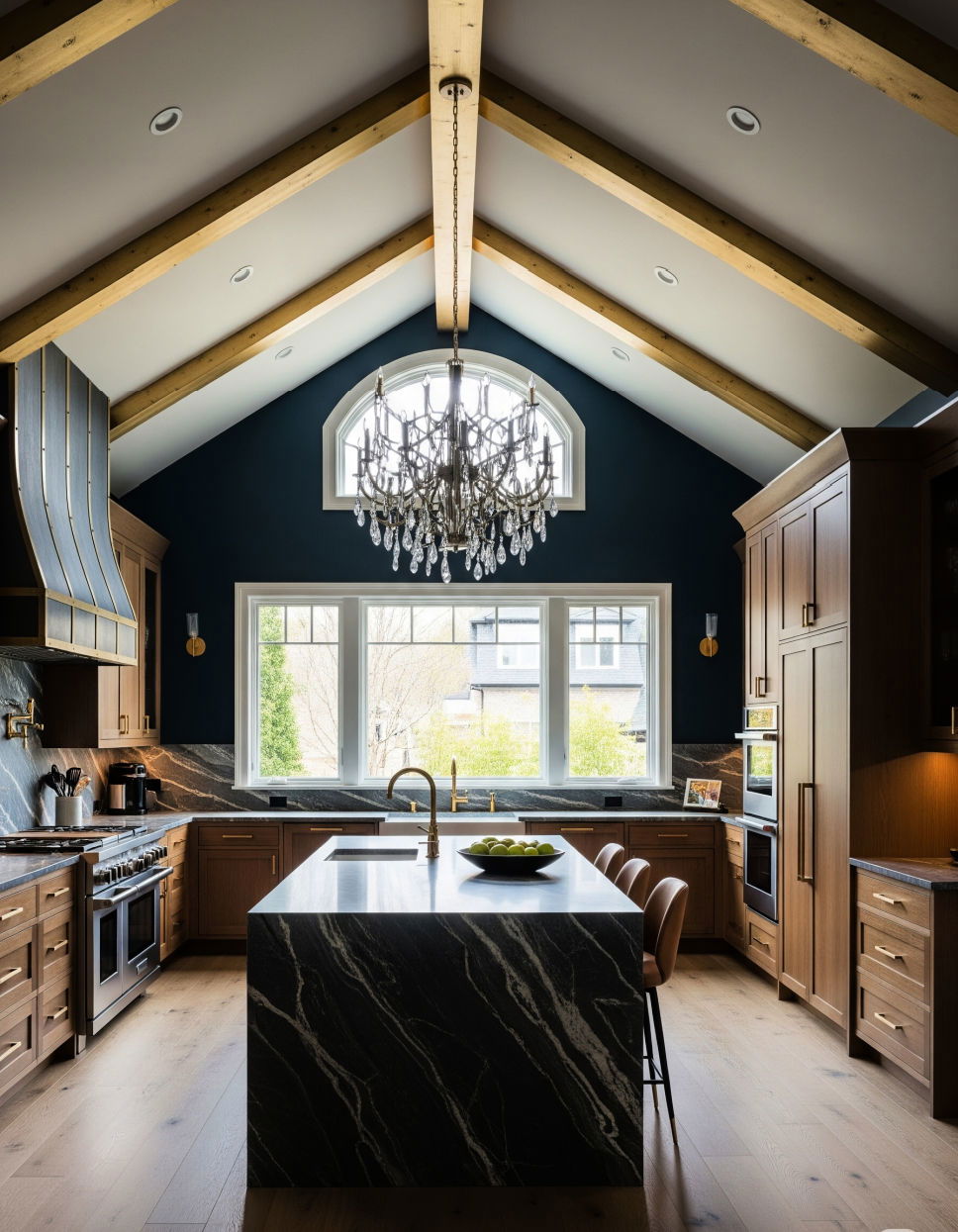
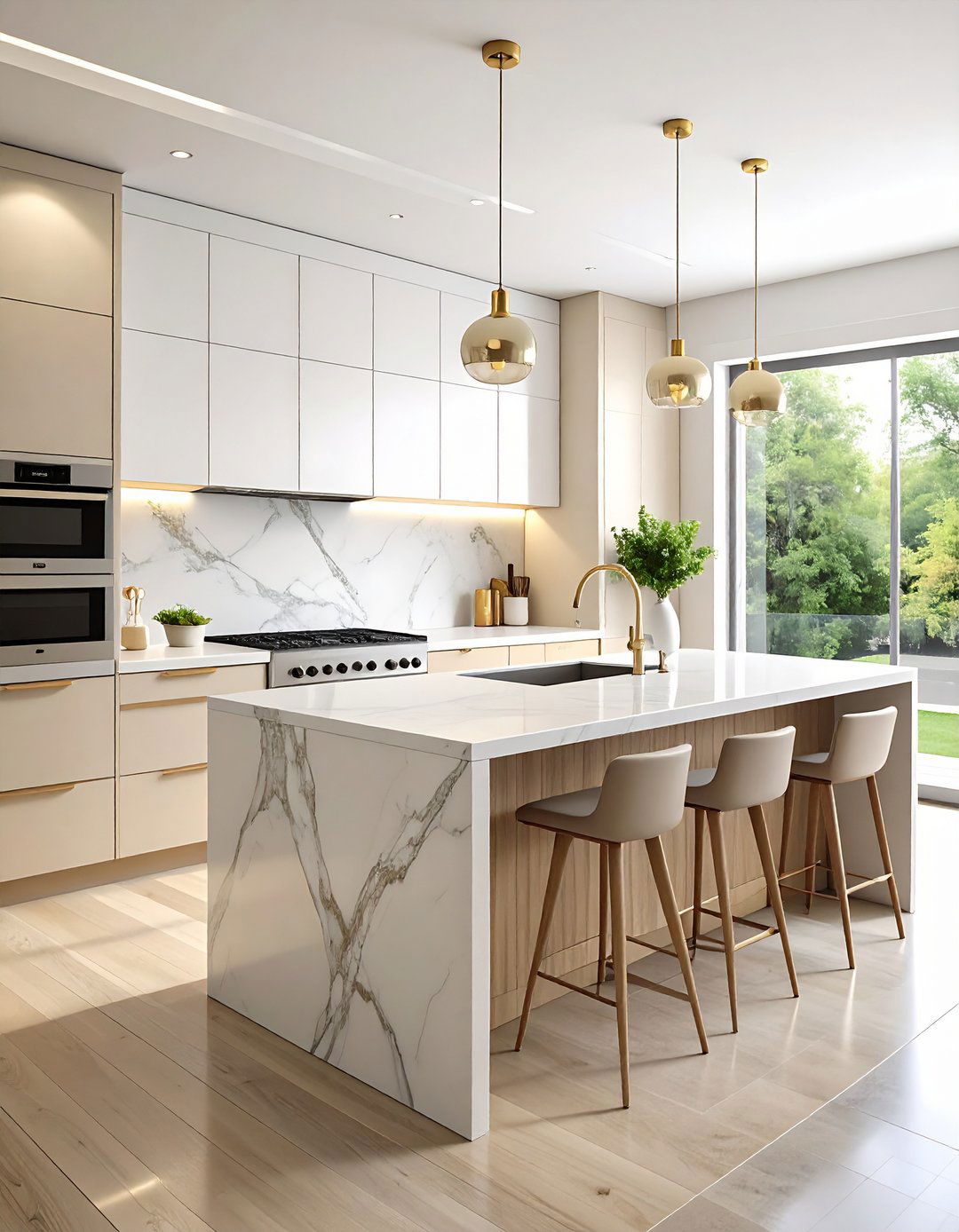
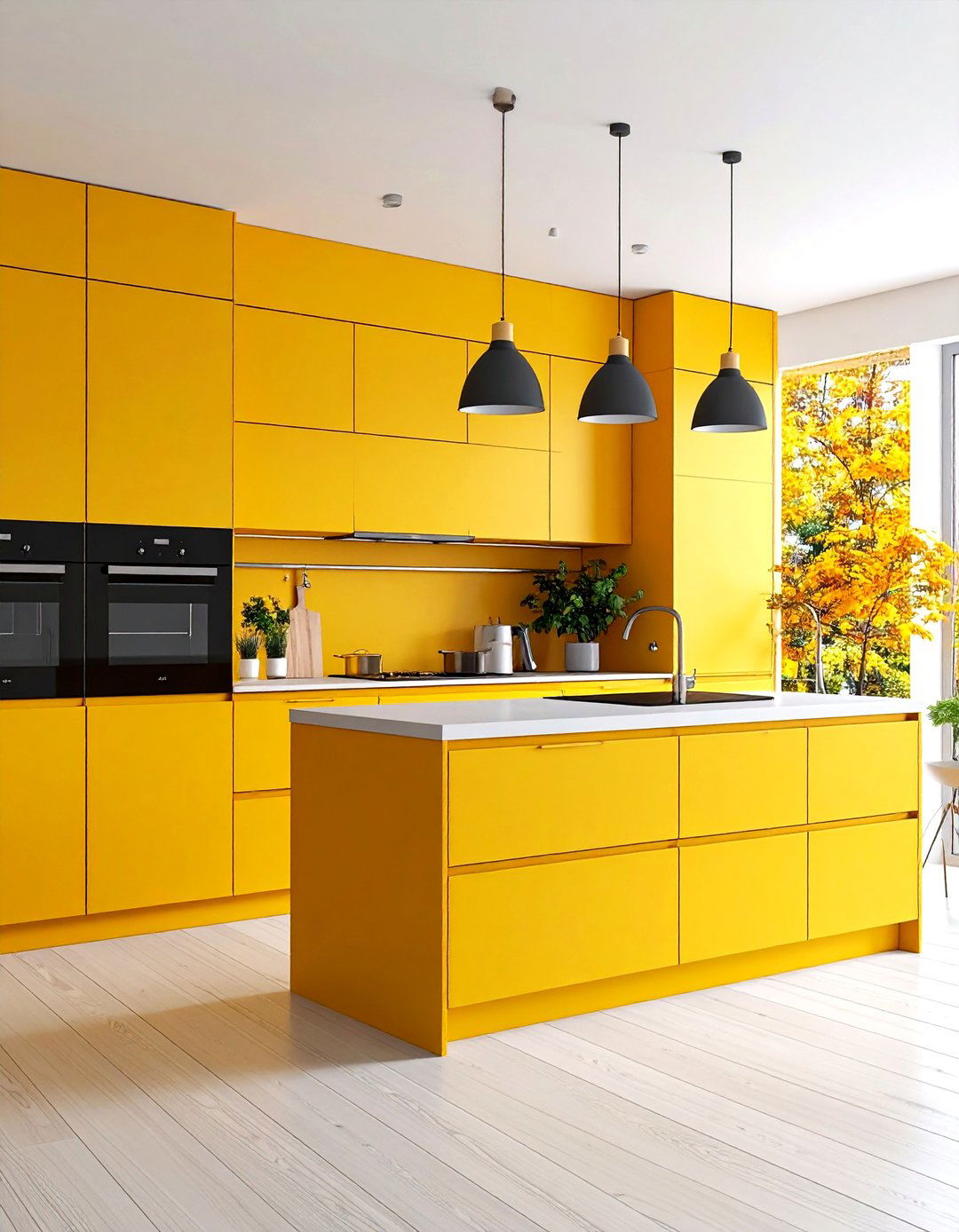
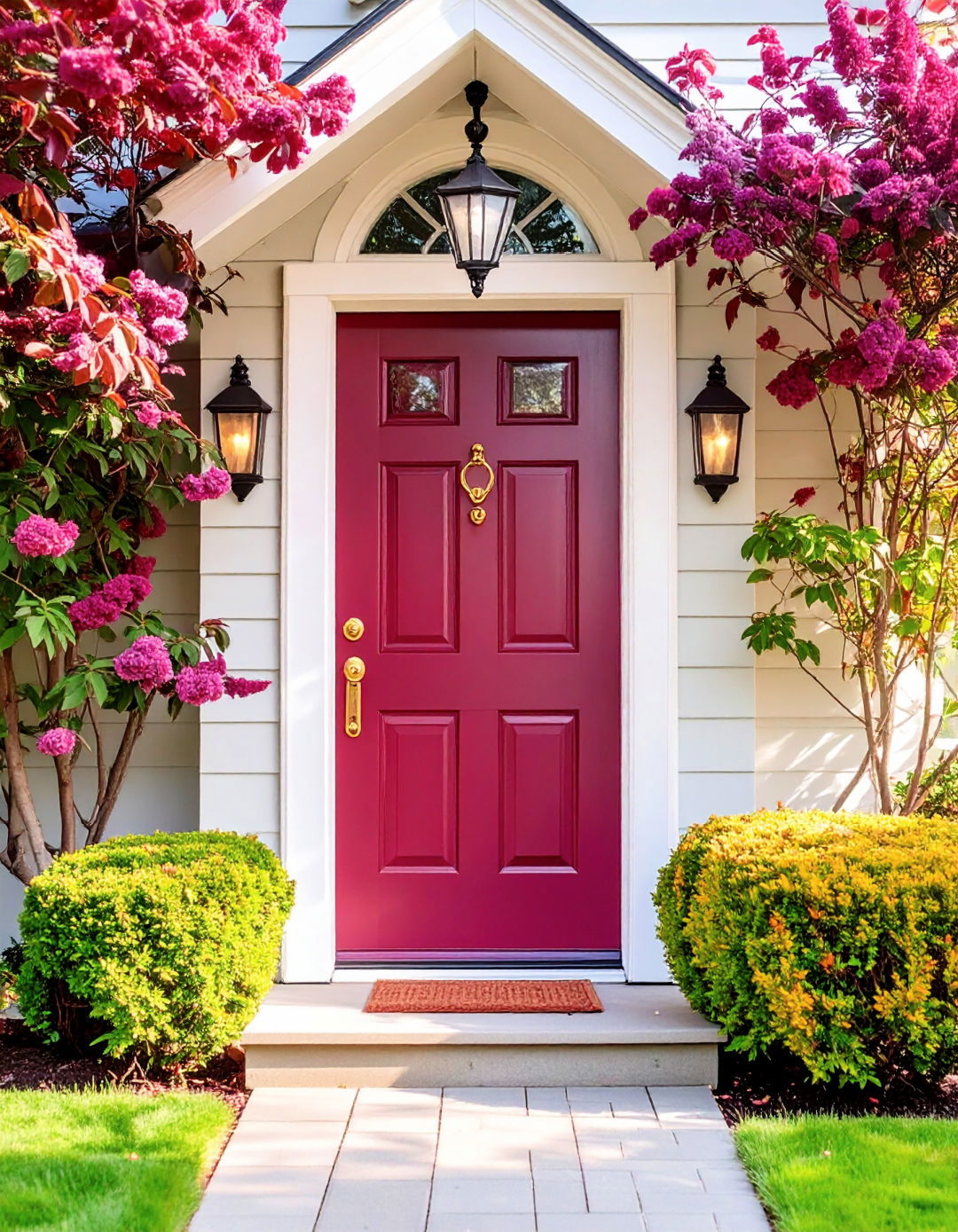
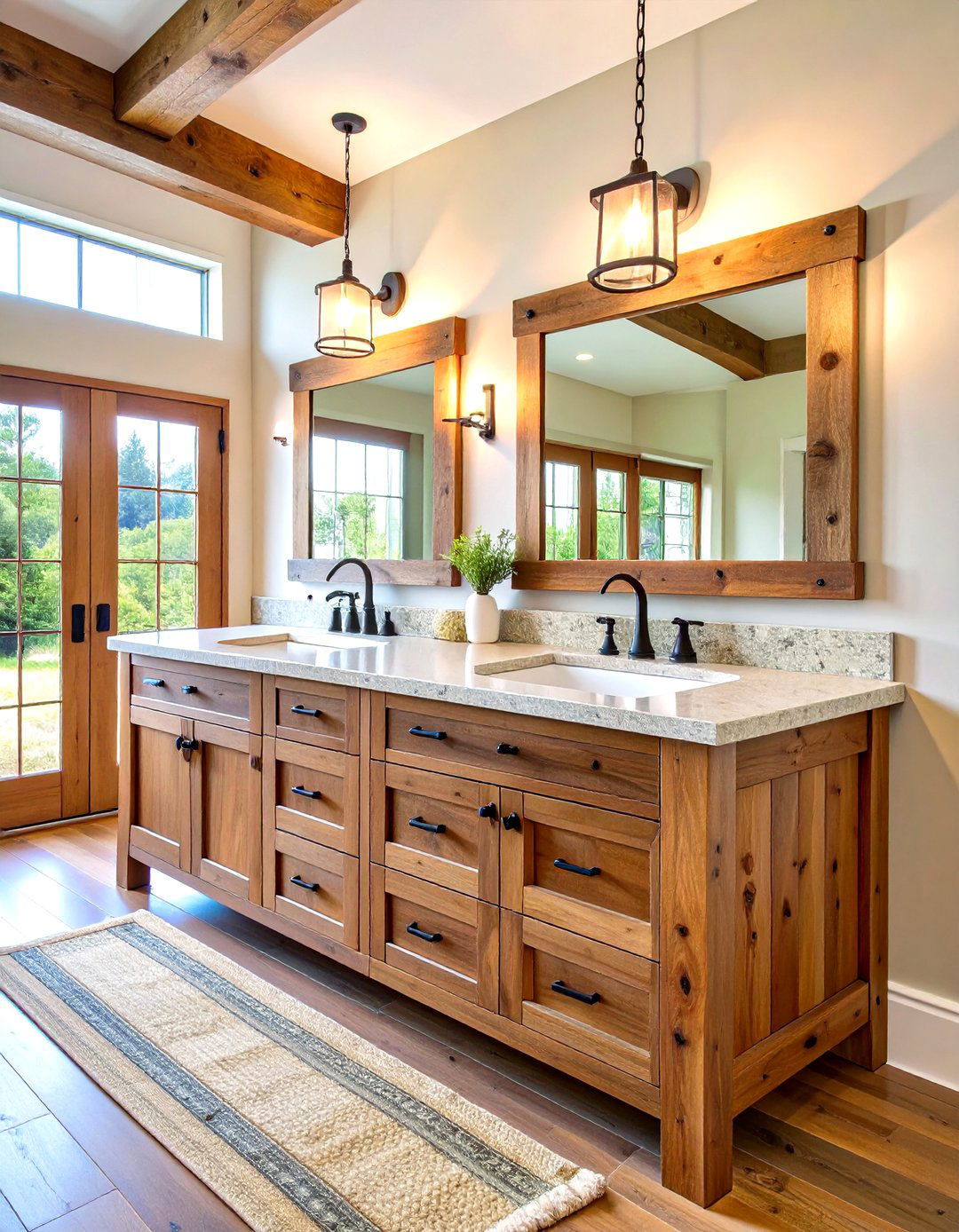
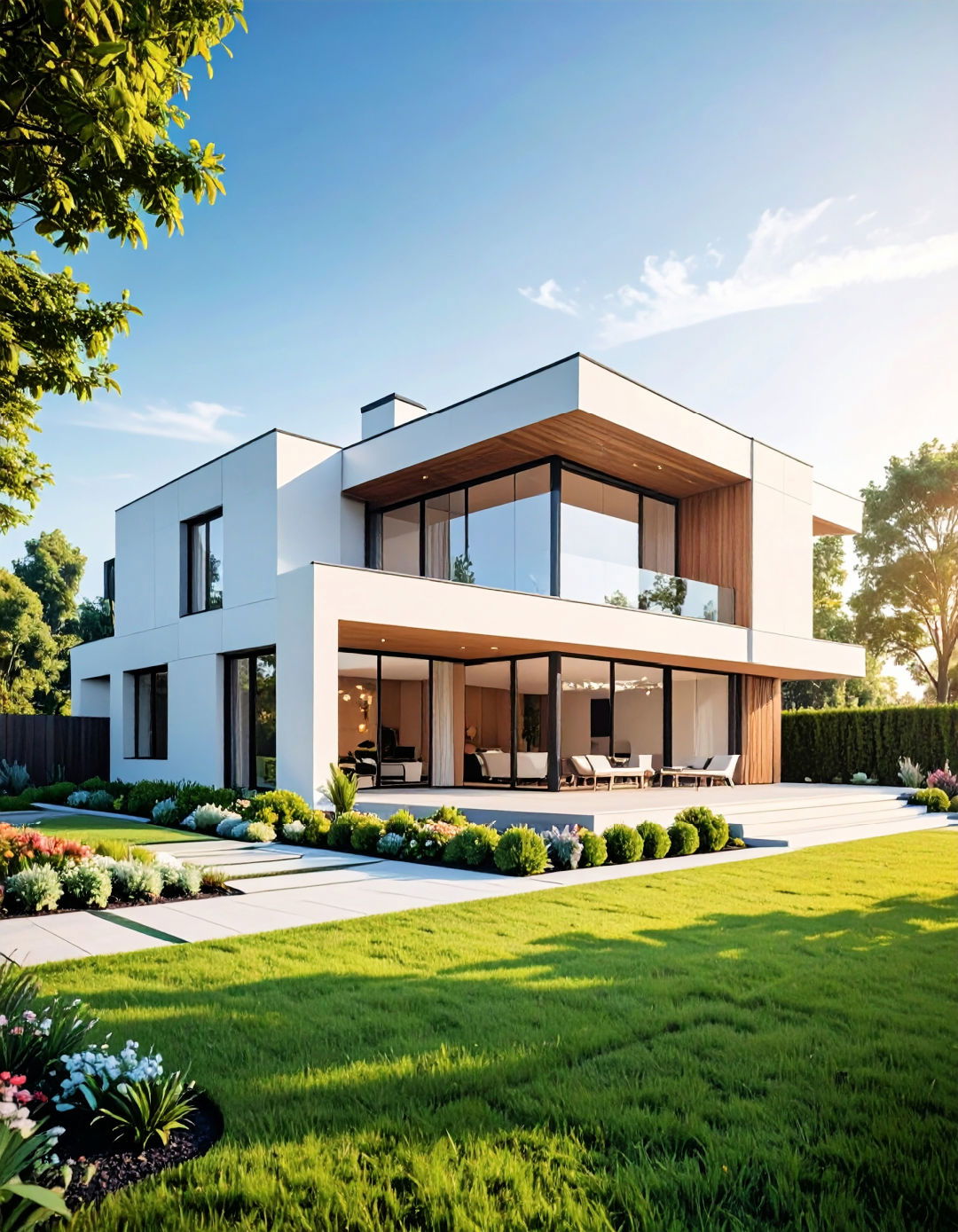

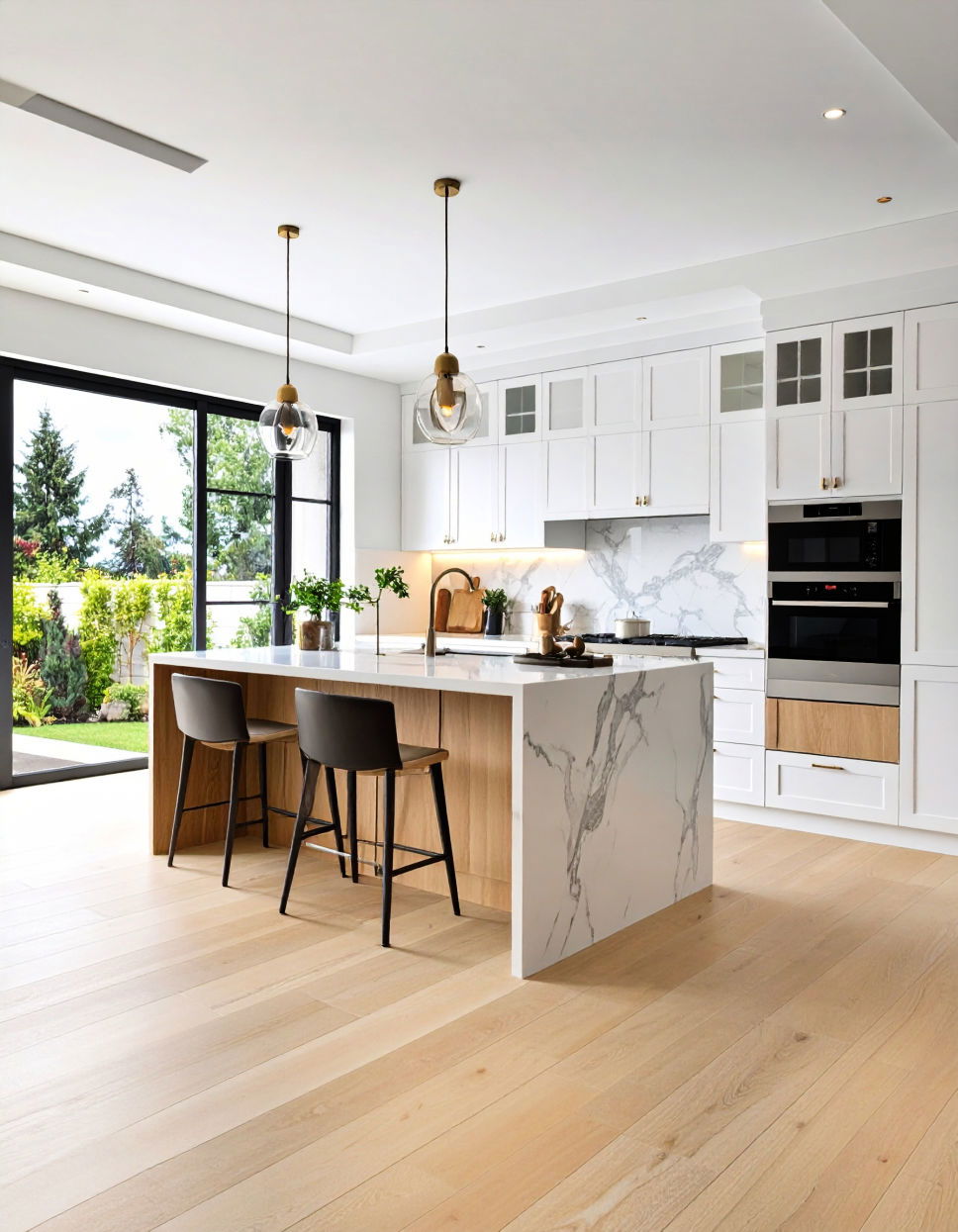

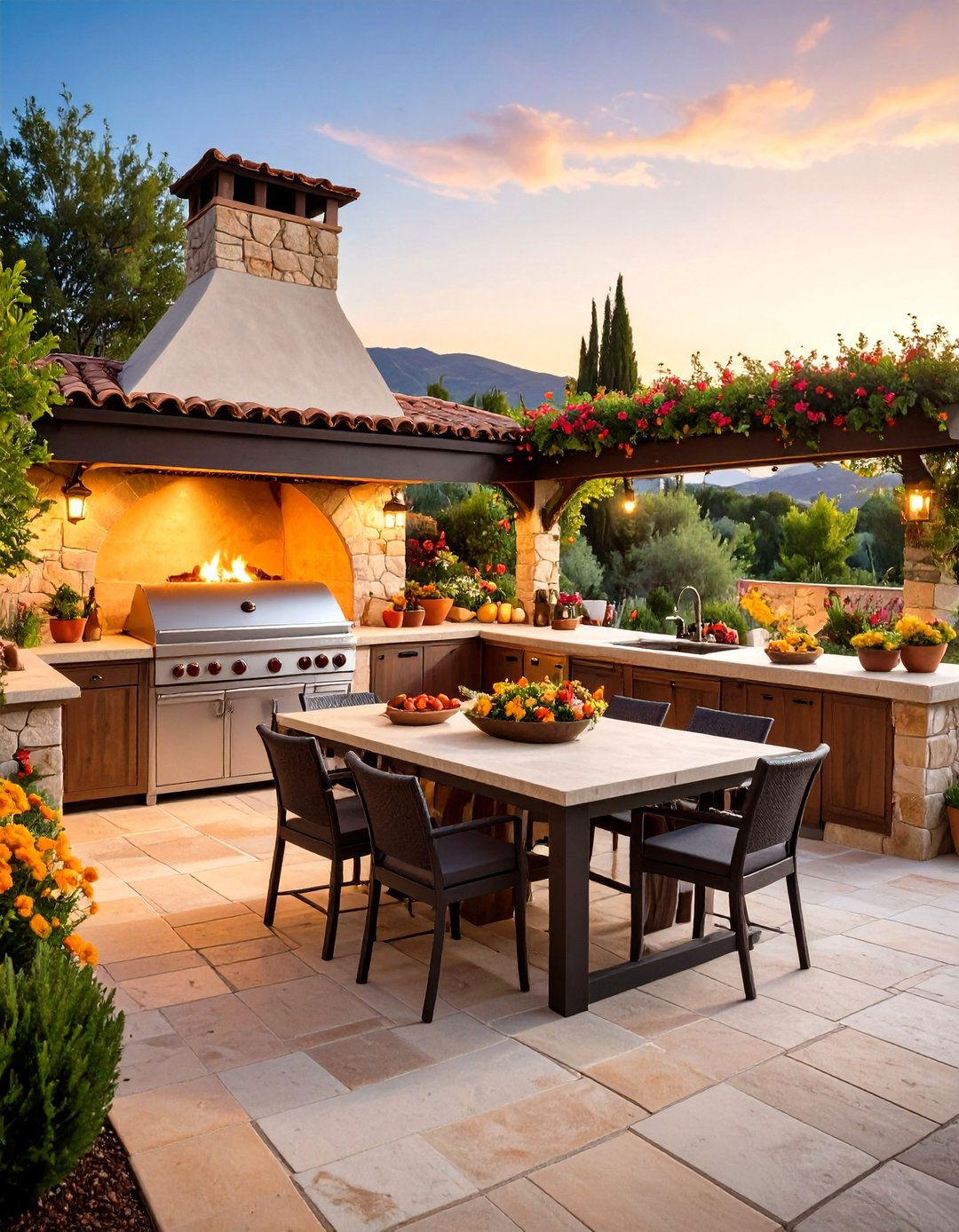
Leave a Reply